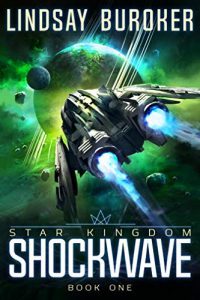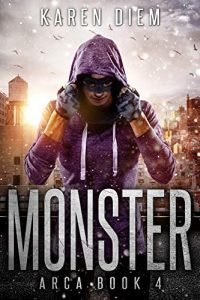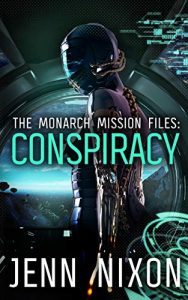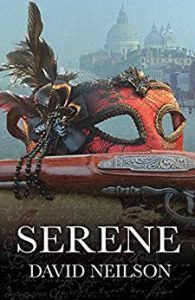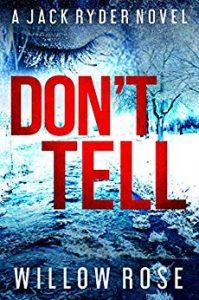Cora Buhlert's Blog, page 70
June 7, 2019
The Gradual Vanishing of the Planetary Romance
At File 770, Mike Glyer linked to this list of the “top ten space opera books of all time”, as chosen by the visitors of a site called Discover Sci-Fi.
The list is rather idiosyncratic, to say the least, and the longlist is just as idiosyncratic. The heavy presence of indie authors who are little known outside the Amazon/Kindle Unlimited eco-system can be explained by the fact that Discover Sci-Fi is a promo site for indie science fiction. Nonetheless, it is hard to imagine someone conducting a poll for the best all-time space opera in 2019 and failing to include the Imperial Radch trilogy by Ann Leckie or the Machineries of Empire trilogy by Yoon Ha Lee or Becky Chambers’ Wayfarer novels or Vatta’s War by Elizabeth Moon or the Binti trilogy by Nnedi Okorafor or the Xuya Universe stories by Aliette de Bodard, etc…
So of course, there is plenty of quibbling with this top ten list in the comments at File 770, including people pointing out that Dune is not really a space opera at all, but planetary romance.
This led to a debate about the differences between space opera and planetary romance, including this comment by Paul Weimer, which I’ll quote below in its entirety:
RE: Space Opera.
I saw JJ’s comment above about Space Opera and wonder just how much space is required to make a Space Opera a Space Opera, as opposed to being something more akin to Planetary Romance. We do get intrigue and the like on a variety of planets, we get a Crossing, and off-planet concerns. But Dune (as opposed to its sequels) is much more bound and Dune itself is tied to the planet Arrakis in a way that, say, a chunk of the Vorkosigan verse is not. Or Harrington. Or The Expanse.
Velocity Weapon (which I reviewed today and also have podcasted with the author about) takes place on a planet, but also a space ship, and has scenes on a different alien planet. But those planets feel much less “place” than Arrakis does for Dune
Paul is correct, for while the boundaries between space opera and planetary romance are fluid, in planetary romance the focus is on one world, even if there are others in the background, and the geography and ecology of the planet in question play a much bigger role in the plot than for space opera. Meanwhile, how to get to the planet in question doesn’t particularly matter to planetary romance, but usually matters a whole lot to space opera. Not that there aren’t a lot of edge cases. Dune is one, because it’s essentially a planetary romance set in a space opera universe. Provenance by Ann Leckie is usually classified as space opera and is definitely set in a space opera universe, but much of the book takes place on a single planet, which not only has its own unique culture, but also ancient alien artefacts/ruins which is a classic planetary romance trope. And while the Vorkosigan series by Lois McMaster Bujold is unambiguously space opera (as well as half a dozen other genres), individual books veer towards planetary romance and the first third or so of Shards of Honor is pretty much pure planetary romance with Cordelia and Aral marooned and evading the hostile environment of the planet that will eventually be known as Sergyar.
Nor are these edge cases a new phenomenon, for while Leigh Brackett is known as the “queen of space opera”, much of what she wrote is actually planetary romance. Meanwhile, Planet Stories, the pulp magazine which published many of Leigh Brackett’s stories in the 1940s and 1950s, is a wild hodgepodge of planetary romance and space opera. So in short, space opera and planetary romance were sister subgenres from the start.
However, while space opera is still going strong and is actually having a moment in the cultural limelight right now, planetary romance has much faded since its heyday in the first half of the 20th century. There are several works that might be classified as planetary romance on the 1944 Retro Hugo ballot, either outright (Perelandra) or edge cases (“The Citadel of Lost Ship” by Leigh Brackett, “Symbiotica” by Eric Frank Russell, “Clash by Night” by Henry Kuttner and C.L. Moore). Meanwhile, there is only one story on the 2019 Hugo ballot that seems to start out as planetary romance, but turns into a completely different subgenre about a quarter in.
The question now is why did planetary romance decline, while space opera remained as popular a subgenre (with periods of waxing and waning) as ever? Part of the reason may be that, as I wrote in this post about the golden age, a lot of planetary romance was set in a version of the solar system that doesn’t exist, where Mars is a desert world full of haunted ruins, Venus is a fog-shrouded swamp and jungle world and pretty much every other place in the solar system is not just habitable, but has its own native life. Space probes pretty much eliminated these settings except for deliberately retro projects like the Old Mars and Old Venus anthologies of a few years back (which are of course pure planetary romance). But then, the inhabited Mars and Venus stories were largely gone by the 1950s, while planetary romance moved further afield into wholly imaginary worlds.
For while planetary romance was having its heyday in the first half of the 20th century, it was still going strong well into the 1970s and 1980s. Dune, the example that inspired this post, dates from 1965 and still has sequels, now written by Frank Herbert’s son Brian and Kevin J. Anderson, coming out. Ursula K. Le Guin’s Hainish Cycle started out in the 1960s and continued up until the turn of the millennium. Andre Norton’s Witch Wolf and Forerunner series started in the 1960s and also continued into the 21st century. Ditto for the Pern books by Anne McCaffrey, which continued – later co-written by Anne McCaffrey and her son Todd – until 2012. The Gor books by John Norman (hey, I never said that planetary romance was necessarily good) also started in the 1960s and continue to this day, though the heyday of the series was in the 1960s through 1980s. The Helliconia trilogy by Brian Aldiss dates from the early 1980s. Ditto for the Majipoor books by Robert Silverberg, a series which still had books and stories coming out well into the new millennium. C.J. Cherryh is still writing as well and a lot of her books are planetary romance.
Of course, those authors are either gone by now or getting on in years, so maybe the fading of planetary romance is simply the result of a generational shift in science fiction. However, there are still books being written and published which would have been called planetary romance once upon a time. Two of the most noted science fiction releases of 2019, The City in the Middle of the Night by Charlie Jane Anders and A Memory Called Empire by Arkady Martine, are planetary romance. Planetfall by Emma Newman is another planetary romance, though several of the sequels are not. One could even make a case for the Broken Earth trilogy by N.K. Jemisin, which is after all one of the most highly acclaimed SFF series of all time, as planetary romance. So planetary romance is still around and successful, winning awards and accolades. It’s just no longer called that.
When I started reading SFF in the 1980s, the term “planetary romance” was still commonly used for planet-bound science fiction with a strong sense of place. I don’t know where or when I first encountered the term. I acquired a lot of SFF knowledge via osmosis, because the critical and non-fiction books about the genre were usually too expensive for me to buy, so I read them in any bookstore that was kind enough to let me and retained as much information as I could. In fact, I strongly suspect I first came across the term “planetary romance” in the venerable Encyclopedia of Science Fiction, which I used to browse in the comfortable leather chairs of Donner Boeken in Rotterdam in their awesome flagship store designed by what has to be time lords. At any rate, I already knew by the late 1980s that Star Wars, Star Trek, Captain Future, Dominic Flandry and the Foundation series were space opera, while the Pern books, Dune, the Skaith trilogy or the Barsoom and Amtor novels were planetary romance.
However, the term “planetary romance” seems to have fallen out of favour sometime in the past twenty years. I’m not sure why this happened, especially since it’s a really useful term to describe a certain type of SFF story. Maybe it’s because the “romance” in “planetary romance” – though it’s “romance” in the older sense of “adventure story” rather than in the newer sense of “love story with an optimistic ending” – puts off people or causes them to assume that it’s a romance subgenre.
In recent years, I increasingly see the term “sword and planet” used instead of “planetary romance”. Now “sword and planet” isn’t a new term, but dates to the 1960s just like its analogues “sword and sorcery” and “sword and sandal”. But until fairly recently, sword and planet was much less frequently used than planetary romance. But if you look at the Wikipedia entries for “planetary romance” and “sword and planet”, you’ll find that the latter is much longer and more detailed than the former. Now I actually like the term “sword and planet”. But while it is certainly a subgenre of planetary romance, there are plenty of planetary romances that are not sword and planet stories, e.g. Dune or Helliconia or the Hainish Cycle or C.J. Cherryh’s works are not.
In additional problem is that while “space opera” has its own BISAC category and is a separate subgenre category at most online booksellers, “planetary romance” or “sword and planet” doesn’t have their own category (but Cyberpunk, which would be easy to subsume under “dytopian fiction, has its own category). As a result, a lot of planetary romance ends up classified as space opera, because that is often the closest possible category. The rather nebulous “action and adventure science fiction” category would fit as well and indeed, I’d be very happy if “action and adventure science fiction” were renamed/reclassified as “planetary romance”.
And if more and more newer readers and writers see books which would once have been called planetary romance called space opera instead, they’ll eventually start referring to e.g. Dune or the Barsoom books as space opera. What is more, particularly self-published SFF authors often don’t have a whole lot of knowledge about the history of the science fiction genre and have never encountered older subgenre terms that don’t have their own category in the Kindle store. And so, books which actually are planetary romance or science fantasy (all of those dragon and mages in space books that were popular approx. a year ago) are instead classified as space opera, while space opera becomes conflated with military science fiction. Indeed, I have seen indie SFF authors insist that e.g. Becky Chambers books are not space opera, because they have no space battles and comparatively little action.
Of course, genre terms and definitions are always in flux, but I’d hate to see the good old planetary romance gradually vanish altogether, because it is a useful term to describe a certain type of story. And since we don’t have a better term, sticking with planetary romance seems like the best bet.
 Send to Kindle
Send to Kindle
June 4, 2019
Cora is time-travelling to 1964 to revisit the Edgar Wallace movies
My latest post is up over at the Hugo nominated fanzine Galactic Journey. This time, I talk about the West German Edgar Wallace movies of the 1960s, a subject about which I’ve written in these pages before.
Of course, it’s 1964 at Galactic Journey. Edgar Wallace movies are still in black and white only (well, the black and white ones are usually better than the colour films) and the latest one to hit German cinemas was the otherwise unremarkable Die Gruft mit dem Rätselschloss (The Curse of the Hidden Vault). Meanwhile, Der Hexer/The Ringer won’t even premiere until August. So of course, I’m writing from the POV of someone watching the movies at the height of both their popularity and quality.
So head over to Galactic Journey and check it out.
 Send to Kindle
Send to Kindle
June 2, 2019
First Monday Free Fiction: Lovers’ Lane
Welcome to the June edition of First Monday Free Fiction. To recap, inspired by Kristine Kathryn Rusch who posts a free short story every week on her blog, I’ll post a free story on every first Monday of the month. It will remain free to read on this blog for one month, then I’ll take it down and post another story.
[image error]This month’s story Lovers’ Lane is part of my The Day the Saucers Came… series:
June 9th, 1956, known all over the world as “the day the saucers came”. Now, for the first time in print, read these sensational eyewitness accounts from people who were there and lived to tell the tale. Prepare to be shocked and horrified, as you read what it was truly like – on the day the saucers came…
Today, we present you the thrilling tale of Betty Miller, then sixteen years old, who drove out to Lovers’ Lane with her highschool sweetheart Cody Barrett on…
…the Day the Saucers Came.
Lovers’ Lane
June 9th, 1956. It was the night I drove out to Lovers’ Lane, the night my life changed forever.
Looking back, I really should have known better than to drive out to Lovers’ Lane with Cody Barrett. After all, everybody knew what happened at Lovers’ Lane, what the boys and the girls who went there did.
Not that I really knew what went on at Lovers’ Lane — no, I was far too naïve and innocent. But I knew that what the boys and girls did there was bad and sinful. Good girls like me, girls who wanted to go to college and marry a good husband one day, didn’t go to Lovers’ Lane and they didn’t do that sort of thing. Only sluts and hussies did. Not that I really knew what sluts and hussies were either. But like every good girl, I knew a slut when I saw one.
But I was young, barely sixteen years old, and so very much in love with Cody Barrett. Cody and me, that was true love — the kind that lasts forever. Or so I thought.
That night, Cody and I had gone to the sock hop in the gym of Herbert Hoover High School. I was wearing my very best dress — white polka dot organdy with a petticoat and a wide belt of shiny red vinyl. I wore bobby socks and saddle shoes polished to a high gloss, my hair was in a ponytail and I looked pretty, as pretty as I’d never looked either before or since in my life.
I danced with Cody all night long. During a break, we sneaked outside to catch some air and Cody used that opportunity to give me his high school ring. I was sporting it on my finger, wrapped with a rubber band to make it fit, and showed it to everybody who wanted to see it and many who didn’t. For this ring, this ugly thing of gilded pot metal and rhinestone that didn’t even fit properly, was the symbol of our love, the sign that made it official. Cody and I were going steady. We were in love. And come graduation, we’d get engaged and eventually married.
And so, when Cody asked me if I wanted to drive out with him to Lovers’ Lane that night, I said, “Yes, I do.”
For even though the girls who drove out to Lovers’ Lane with their boyfriends were all sluts and hussies, that didn’t apply to me. After all, Cody and I were in love. We were as good as engaged and one day, we would get married. And if you were engaged or as good as, then there was nothing wrong with driving out to Lovers’ Lane. Nothing at all.
Cody had an old powder blue Chevrolet. We both got in, he in his baby blue tuxedo with matching cummerbund and me in my best polka dot dress. The skirt was so wide that it got caught in the door of Cody’s Chevy, soiling the delicate fabric with grease. I was really angry about that, too. Because back then, I still thought that soiling my best dress on the door of Cody Barrett’s Chevrolet was the absolutely worst thing that could happen to me that night.
“Don’t worry yourself,” Cody said after examining the soiled hem of my best polka dot dress, “The grease will wash out. After all, your folks have got one of them new washing machines, don’t they?”
I nodded, because my Mom did have a washing machine, a true miracle of technology that was supposed to clean even the worst stains.
And then we drove out to Lovers’ Lane. All the way, Cody had the radio on. There was a baseball game on and — more importantly — music. That sweet hot rock ‘n roll music that my parents wouldn’t let me listen to, let alone dance to, because good girls didn’t do that sort of thing. But then, good girls didn’t drive out to Lovers’ Lane with Cody Barrett either. And if I was about to do the one, then I could do the other just as well.
***
I don’t know what I had expected Lovers’ Lane to be like. I mean, I knew where it was. Everybody in town knew. I’d driven past that spot often enough, sitting in the backseat of my Dad’s Studebaker, while Mom lectured me from the front seat about how Lovers’ Lane was this horribly evil den of sin where only the bad girls went, only the hussies and the sluts.
Still, in my mind I had painted the place as this perfect wonderland of romance. The reality was… underwhelming. For in truth, Lovers’ Lane was merely a place known as Sighing Pine Ridge, a plateau which overlooked our town. By night, it was a lonely place and also almost completely deserted, except for the cars of the couples who came here to do whatever sinful thing it was that couples did at Lovers’ Lane.
Cody drove his Chevrolet right up to the edge of the plateau and stopped. He turned off the ignition, but left the dashboard lights and the radio on. There was a live broadcast of a baseball match, the Yankees versus the Dodgers. I remember it like it was yesterday, remember the announcer breathlessly calling out strikes and home runs, remember the names of the players, Mickey Mantle, Don Larsen, Don Newcombe, Jackie Robinson, Roy Campanella, Joe Black. I never much cared for baseball — though Cody did, which is why I suspect he left the radio on that night — but I can still recite the names of those players, like a prayer, a reminder of the last normal night on planet Earth.
Still, for the time being, it all seemed normal enough. We just sat there in Cody’s car, parked right at the edge of the ridge at Lovers’ Lane, watching the stars and listening to baseball on the radio. For the sky was clear that night, as clear as it could ever be, and the stars were shimmering like so many diamonds on midnight blue velvet. It was peaceful and beautiful and there was absolutely no sign that anything was amiss, anything at all.
Cody draped his arm around my shoulder, but otherwise we just sat there next to each other, staid and polite, while Cody’s breath quickened, as Mickey Mantle scored another home run. And for a moment I thought, “This is all?” All that talk about the sinful things happening at Lovers’ Lane, and yet we just sat there next to each other, his arm round my shoulder, with the gearshift as a safety barrier between us.
Truly, I had seen more sinful going-ons at the local drive-in, when a monster movie was playing and I averted my eyes from the horrors on the screen to see Judy Burns and Archie Simpson engaged in some very heavy, very sweaty kissing and groping in the car next to ours. By comparison, what we were doing was positively harmless and wholesome. Of course, Judy Burns had always been a slut — everybody in town knew that — but nonetheless, the discrepancy was striking.
Or maybe we were doing it all wrong? After all, how could I be expected to do anything sinful at Lovers’ Lane, when I didn’t even know what the sinful things people supposedly did there were? Maybe I was just… unentrancing. Maybe Cody was just waiting for me to do something, only I didn’t know what?
But that slut Judy Burns, she sure as hell knew what to do. Maybe I should have asked her what to do before coming here tonight. There was only one problem. I didn’t speak with Judy, since Judy was a slut and one did not speak with sluts. Never mind that Judy hadn’t even been at the sock hop that night. She preferred the company of boys with motorcycles in black leather jackets these days.
On the radio, Mickey Mantle scored another home run and then a commercial came on. A commercial for mouthwash — so your husband will be happy to kiss you good-bye in the morning and welcome home in the evening. Briefly, I wondered whether I should have used mouthwash. For what if my breath smelled bad? What if that was the reason why Cody didn’t want to do any of the sinful things people supposedly did here?
But then Cody suddenly pulled me close and kissed me. The knob of the gearshift pressed into my ribs and Cody obviously hadn’t used any mouthwash either, for he still tasted of the overly sweet punch they’d served at the sock hop. But we were kissing and the stars were shining overhead like so many rhinestones on a chorus girl’s gown and the moment was absolutely perfect.
We kissed, until we both had to come up for breath. And once we had — taking hasty, panting gasps of air — we dove right in again.
It wasn’t long until I felt Cody’s hands on my body, not wrapped around my back, where they belonged. No, his left hand was on my breast, its warmth radiating through my Maidenform bra, while his right was on my thigh, working its way up beneath my petticoat, both places where they definitely did not belong.
Feeling his hands on my body — in places where they shouldn’t be, at that — gave me a jolt as if I’d just touched a live wire. I sat bolt upright, stiff like on of the chairs in my grandma’s parlour. On the radio, Mickey Mantle scored another home run.
Cody was jolted out of his awkward fumbling as well — or maybe it was just the impact of Mickey Mantle, winning another victory for the Yankees.
“What’s wrong?” he asked, his breath coming in short, laboured puffs.
“I… I don’t think we should do… this,” I said, backing away, until I came up hard against the passenger side door.
I noticed that my skirt — the wide, full, polka-dotted skirt of my very best dress — had hitched up and so I self-consciously smoothed it down again, drawing the stiff organdy down over my knees again. I remember how my mother had admonished me — years before when I was still a tomboy who liked to climb trees and catch bullfrogs — about sitting cross-legged on one of the chairs in our kitchen, my gingham dress hitched up, knickers in full view. “A lady…” she’d said — and I heard her voice echoing in my ear, as if it was yesterday, “…never sits with her legs apart.” And though I didn’t know why, I pressed my knees together tight, as if my life depended on it.
Cody’s face was flustered, pimples standing out like bright pinpoints of red on his cheeks and his nose and his forehead. “Why? You… you like me, don’t you? I mean, you said that you liked me. Said that you want to go steady. I gave you my ring, for heaven’s sake. And now you suddenly don’t want to put out?”
“It’s wrong,” I said, though I didn’t know how I knew that. All I knew was that the feelings I was feeling — the itch, the excitement and the throbbing warmth spreading from my breasts all the way down into my belly — that it just wasn’t natural. It was sinful… and wrong. The very thing my mother and grandmother had warned me about.
“We… we shouldn’t do this.” I crossed my arms over my chest, while another Yankee — Don Larsen this time around — scored yet another home run.
“So you don’t love me?”
“Of course, I love you. But…”
There was a roar on radio, as Joe Black of the Dodgers scored a home run. In my mind, I heard my mother’s voice. “Never trust a man when he says he loves you. Cause men lie. It’s in their nature. So always demand proof that he’s serious before you put out.”
Did being here in a car with Cody Barrett on Lovers’ Lane count as “putting out”? I didn’t know. But my Mom was always going on about girls who lifted their skirts too quickly and how no man would want them afterwards, no proper man at any rate. And Cody had tried to shove his hand under my petticoat, so I guess it did count. Besides, better safe than sorry.
“…it… it’s just not proper, not right.”
“Why not? We’re in love, so how could it be wrong?”
My mother’s voice echoed in my mind again. “Love is not enough. Demand commitment. Demand proof.”
I looked at Cody’s high school ring on my finger, the rhinestone gleaming dully by the dashboard light. Was a ring commitment enough? Oh, a diamond ring sure was, but a gilded high school ring with a fake jewel made of cut and tinted glass? And how did you demand commitment anyway?
I reached out and took both his hands in mine, as much as a gesture of love as to keep him from shoving them under my petticoat again.
“I love you, I really do,” I said, hoping that he’d understand, “But first I need to be sure. I need to know if it’ll last, if you’ll love me forever.”
I hoped that he’d say it. Hoped that he’d drop to his knees right there and then and declare that he’d love me forever and ever till the end of time.
But Cody disappointed me, disappointed me for the first time since the day I’d seen him chatting with that slut Judy Burns at the counter of the soda fountain. And that had been a mistake, cause Cody had sworn to me that it was all perfectly harmless, that she’d only asked him about the homework assignment for the American history class they had together.
This time, however, it was no mistake. For instead of declaring his eternal and undying love for me, Cody shrank back. His face was pale, his hair tousled and scattered red pimples on his cheeks stood out like pinpricks in the artificial light cast by the dashboard.
“I… I don’t know.”
“But I thought you loved me,” I said, “You swore that you loved me. So why can’t you say that you’ll love me forever.”
“I… I don’t…”
“Say it,” I demanded, “Either say it or take me home, now.”
“I don’t know, okay. Forever is a pretty long time. And if I get a scholarship, I’ll be going to college next fall.”
“And once you’re in college, you’ll just forget all about me?” I demanded.
Mom had been right. Men did lie. They told you they loved you and then they just forgot about you, just cause they’d gotten a scholarship for some fancy college full of fancy and sophisticated college girls.
“No… that is, I don’t want to. But lots of things can happen in a year. I mean, you could forget me, once I’m away at college.”
“I won’t forget you,” I declared, “I love you. I love you forever and ever and till the end of time.”
“And I love you, too,” Cody said, but his voice sounded weak, his words half-hearted, “I really do. But college… that could change everything.”
“If you really and truly loved me, you wouldn’t hesitate. You’d say that you love me and wouldn’t wait for college. You’re just a liar, a goddamned liar, like all the other guys.”
I reached for the door handle, but it wouldn’t open. Plus, I suddenly remembered that I was at Lovers’ Lane, in the middle of nowhere, far from the next highway, let alone a bus stop or a payphone. I’d have to walk home, in my bobby socks and my very best saddle shoes. And I’d be damned if I would walk home, just because Cody Barrett was a liar, a dirty, stinking rotten liar, like all the boys.
So I turned to Cody, my hands crossed over my chest. “You’ll take me home,” I said. My voice was dripping with ice and so loud that I even managed to drown out Mickey Mantle’s latest home run. “Now.”
“But Betty, that… that’s not fair. After all, I gave you my ring and you said you’d drive out to Lovers’ Lane with me after the dance. You can’t just say no.”
“Either you say you’ll love me forever and ever or you’ll take me home,” I said, “Your choice.”
Cody considered. He considered, as Jackie Robinson of the Dodgers scored a home run, quickly followed by Don Larsen of the Yankees.
“Okay,” he finally said, “I swear that I’ll love you forever and ever until the end of time. I swear by my life and the life of my mother and father and my little sister. And should I lie, then may the Lord strike me down right here and now.” He paused, out of breath. “There. Satisfied now?”
I nodded. I was satisfied. And if the thought that Cody might be lying just to get me to lift my skirt ever entered my mind, I quickly pushed it away.
Besides, he’d said, “May the Lord strike me down” and the Lord hadn’t struck him down yet, so I figured it was all right. But sometimes, the Lord only needed a little more time. And a little bit of help…
I don’t actually remember much of what happened next. There are flashes. My organdy skirt hitched up, the stiff petticoat sticking up like a halo. My panties tangled between my legs. Cody on top of me, huffing and panting. His hand on my breast, squeezing as if I were a grapefruit. My bare skin sticking to the vinyl car seat. The knob of the gearshift digging into my back. A flash of pain and a bit of wet, as Cody entered me, huffing and puffing like a ramrod. Cody crying out incoherently and shooting a load of hot and wet into my body.
And all the time, while I lay there, I kept thinking, “This is it? This is what everybody is so excited about?”
Cause even though I don’t remember more than flashes, I remember only too clearly how underwhelming the whole experience was. But then whose first time isn’t underwhelming?
It didn’t take very long. Two home runs only, one by Mickey Mantle and one by Jackie Robinson. And when it was over, Cody just collapsed on top of me and lay there, heavy like a sack of flour. After a minute or two, he started snoring.
And still I lay there, vinyl sticking to my skin, gearshift digging into my back, Cody snoring on top of me and Mickey Mantle scoring home run after home run on the radio. I lay there and looked through the car windows up at the stars above and wondered whether this was all, whether this bumpy fumble in the dark truly was what love was all about.
I was a hussy now, I realised with a pang, a hussy and a shameless slut, just like Judy Burns. Briefly, I wondered whether this meant that I, too, could wear pencil skirts and too tight sweaters now and smoke in public and hang out with the boys in black leather on their motorcycles.
But no, I couldn’t be a slut and a hussy. I was a good girl, after all. I was going to go to college and get married and have a lot of babies and a house in the suburbs with a white picket fence.
And besides, Cody loved me. He’d said so, hadn’t he? He’d sworn he loved me, sworn it by his own life and that of his mother and father and little sister. Or may the Lord strike him down…
***
The radio gave out first, static drowning out Mickey Mantle’s latest home run, before it suddenly went dead altogether.
I sighed under my breath. It was going to be a long night.
Next came the humming, a low and ominous rumble in the distance, like an oncoming thunderstorm.
Finally came the light, brilliant, blinding, streaming in through the windows and blanking out the night sky, almost as if we’d parked right next to a floodlight.
“Crap,” I thought, “It’s the cops.”
For the cops sometimes patrolled Lovers’ Lane and shone into the parked cars with their flashlights. And now they’d found us, Cody and me, doing sinful and dirty things here at Lovers’ Lane. And everyone would know…
My poking and the radio dying hadn’t woken up Cody, but the light did. He suddenly jerked upright, banging against the steering wheel in the process, and stared out of the car window, blinking against the lights.
“What… the… hell?”
I was still pinned underneath Cody, so I couldn’t see. “Is… is it the cops?” I whispered.
Cody shook his head. “No. Something a lot weirder.”
He shifted aside, so I could finally sit up, could finally see. So I crawled right up to the driver’s side window and pressed my nose against the glass.
“Oh my freaking God!”
For there, hanging in the night sky above the town, was a flying saucer, a bonafide flying saucer. It was enormous, its diameter easily eclipsing the entire town, and lit up like a Christmas tree all over. On its bottom, there were more lights, gigantic spotlights brighter than the floodlights at the Yankee Stadium in far off New York City, where Mickey Mantle was probably still scoring home runs. And all of those lights were trained on the town, lighting up the streets brighter than the sun on a midsummer noon.
We both scrambled out of the car. I pulled up my panties and smoothed down my skirt or rather I tried, for my best dress was hopelessly wrinkled by now. Even worse, the once pristine white organdy skirt was now marred by an ugly bloodstain. I swore under my breath. Of all the stupid times to get my period.
I hoped, prayed that Cody wouldn’t notice. But I needn’t have worried, for Cody’s attention was riveted on the UFO floating above the town.
Together, we stepped up right to the very edge of Sighing Pine Ridge and looked out across the town below and the saucer hovering above.
Under the bright spotlights of the saucer, we could see the people of the town running about in the streets, looking so much like those little miniature toy figurines in my little brother’s train set.
Occasionally, beams of red light would stab down from the underside of the saucer. They looked quite beautiful really, surprisingly beautiful. When one of those beams hit the street, it would explode in a shower of gravel and dust. But should they hit a building instead, that building would suddenly burst into flames.
“Death rays,” Cody whispered, “They’ve got death rays.”
“More like fire rays,” I whispered back.
They were doing their job, too, for several houses in town were already in flames. The general store was burning, the first Baptist church, the movie theatre and the bank as well as several homes. Another beam stabbed down from the saucer and the gas station exploded in a shower of sparks and flames, hurling cars all over the street. One hit the front of the post office and got stuck halfway through the red brick façade.
“Oh shit!” Cody suddenly exclaimed and it was testament to the fact how extraordinary the whole situation was that I wasn’t even shocked by this display of profanity.
“That’s my house.” He pointed at a spot down in the valley. “And it’s on fire.”
My gaze followed his finger, but unlike Cody I couldn’t make out any individual houses. Instead, it looked as if all of Cypress Avenue and Cherry Crescent were burning. And Cody lived on Cypress Avenue.
It was that sight more than anything else that brought back the reality of what was happening. Our town, our homes, our whole way of life was on fire and all because of an alien invasion.
Cody was still staring helplessly out at the town and at the quiet little street where his house was burning.
I tugged on his sleeve. “Let’s get away from here,” I whispered, “Before they see us.”
Wordlessly, Cody turned around and marched back towards the parked Chevy, back towards salvation. I followed and barely even noticed, let alone cared that the full skirt of my pretty polka dot organdy dress got caught on a bramble and tore.
I assumed Cody and I would get into his Chevy and drive away, away from the town and the saucer and the horror. But Cody didn’t get into his car. Instead, he opened the trunk and took out a flashlight and a tire iron.
“Cody, what… what are you doing?”
“I’m gonna show ‘em,” he muttered, more to himself than to me, “I’m gonna show those little green men they picked the wrong family to mess with.”
“But you can’t take on the aliens,” I pleaded, “They’ve got death rays.”
“They burned down my house and attacked my family. I’ve got to do something.”
“Please, let’s just drive to Whispering Palms Air Force Base,” I said, “They’ll know what to do.”
Cody marched back towards the edge of Sighing Pines Ridge, flashlight in one hand and tire iron in the other. And God alone knows what he hoped to achieve wielding a tire iron of all things against a flying saucer equipped with death rays.
Cody pointed his flashlight up at the saucer. He waved his arms and yelled, “Come on, you Martian bastards! Look at me, damn it.”
Cody got his wish. The Saucermen noticed him.
For an instant, he stood transfixed in a cone of light, yelling “I’m gonna show you…” up at the saucer, while waving his tire iron. Then one of the familiar ruby-red death rays stabbed out of the saucer, so blindingly bright that I had to close my eyes against the glare.
When I opened my eyes again, Cody was gone. And where he had just stood, there was only a pair of smoking shoes and a discarded tire iron glowing red hot.
I stared at the smoking shoes and the glowing tire iron. I stared and remembered what Cody had said to me in the car, barely an hour before.
“I swear that I’ll love you forever and ever until the end of time. I swear by my life and the life of my mother and father and my little sister. And should I lie, then may the Lord strike me down right here and now.”
But sometimes, even the good Lord needed a little help. And so he didn’t strike down Cody himself, he got the Saucermen to do it.
“You lied,” I screamed at the smoking shoes and the tire iron, “You lied, you goddamned bastard!”
I kicked the ground where Cody had stood. I hit one of his still smoking shoes. It went over the edge of Sighing Pines Ridge and tumbled into the valley below.
Far above me, the saucer was still spinning, occasionally shooting death rays down at the town. The Saucermen paid no attention to me. I wasn’t important enough to bother with. After all, I hadn’t lied. I hadn’t challenged the good Lord to strike me down and invited flying saucers and death rays to scorch the whole town.
I ran away then. I didn’t even try to take the car. First of all, because I couldn’t drive. And secondly, because the keys had been in Cody’s pocket when the Saucermen struck him down.
And so I just ran. Away from Lovers’ Lane, away from the burning town and away from the pair of smoking shoes and the glowing tire iron that were all that was left of Cody Barrett, the boy who’d lied to me and brought down the wrath of God onto the whole damned town.
***
I don’t know for how long I ran. I know that I stumbled blindly through the undergrowth. Once or twice I fell and landed face first in the dirt. Twigs and brambles tore my dress, my beautiful polka dot organdy dress, but I was beyond caring.
Eventually, I hit upon the road, the road that led from the town up to Sighing Pine Ridge. I followed the road until it met the highway and just kept walking, away from the town and the saucer.
Only once did I turn around to look back and immediately wished that I hadn’t. For behind me, the entire sky seemed to be on fire, lit up by the blazing town. And above it all floated the saucer like a vengeful god descended from heavens.
I’d known before that I couldn’t go back, that I could never go back. But the sight of the burning sky brought it home more sharply than ever before. So I just kept walking. Somewhere along the way, the heel broke off one of my brand-new saddle shoes, so I just took off both shoes and continued to walk along the highway in my bobby socks.
I would go to Whispering Palms Air Force Base, I decided, and ask for help and sanctuary there. They’d know what to do. And then they’d shoot that damned saucer from the sky.
Whispering Palms Air Force Base was twenty-five miles away, much too far to go barefoot in a single night. But in the end I didn’t have to walk that far. For when I was maybe three miles from the town, I suddenly heard the roar of a car engine coming down the road behind me. And not just any old engine either, but the rumbling whine of a hot rod.
A few seconds later, a Deuce Coupe modded within an inch of its life skidded to a halt beside me. A door emblazoned with bright orange flames opened and out popped Judy Burns and her black bouffant.
“Betty? What are you doing here? Get in.”
If I’d still needed proof that this was the worst night of my life, the fact that I actually got into a car with Judy Burns, the town slut, and three of her beaus would have been it. I barely hesitated, too. I just got into the car, squeezing in next to Judy and a boy I didn’t know, self-consciously smoothing down my skirt, even though it was hopelessly ruined.
Judy noticed it, too. “Oh my God, Betty, you look a fright!”
Judy, of course, looked like she always did, with her pencil skirt, too tight sweater, too red lips and black bouffant. But then even the end of the world could not faze Judy Burns.
“How did you get out?” Judy wanted to know, “We thought the whole town was lost.”
“There were bodies in the streets, people getting zapped, houses exploding into flames,” the boy next to me said. Somehow, he made it all sound very exciting. “The only reason we made it out was because Hank’s hot rod really packs a punch.”
“Damn right, it does,” the driver added.
“I… I wasn’t in town when the saucer came. I… I was…”
Oh, what the hell! The world had just ended, flying saucers had attacked us, so there was really no reason to worry about my reputation anymore. Besides, this was Judy Burns, the town slut. If anybody had no right to judge me, it was her.
But I still blushed and lowered my eyes. “…I was up at Lovers’ Lane with Cody Barrett.”
“Cody? Did he make it out as well?”
I shook my head. “He’s dead. The saucer got him.”
“Oh, Betty, that’s awful,” Judy said, “I’m so sorry. I mean, I know that you and Cody…”
I kept my eyes on the floorboards of the old Deuce Coupe, because I found that I couldn’t look at her. “This is all my fault,” I whispered.
“A fucking flying saucer from outer space came to our town…” Judy replied. And of course, she used the f-word like it was no big deal, “…and started zapping everything in sight. How on Earth can this possibly be your fault?”
“Mars needs women,” the boy in the passenger seat piped in, before the driver silenced him with a pointed glare.
“We… we went up to Lovers’ Lane….” I whispered, “…and we… we…”
“You made love,” Judy supplied, as if it was the most normal and everyday thing in the world. And who knew, maybe to her it was.
Judy suddenly grabbed my hand. “You did make sure he used a prophylactic, didn’t you? Or at least pulled out? Cause you might be in real trouble, if he didn’t.”
I just nodded, though I had no idea what Judy was on about or why she was suddenly so nice to me, when we’d never as much as exchanged a greeting since junior high.
“Before… before I let Cody… touch me, I made him swear that he really loved me and would love me forever…”
From a corner of my eye, I caught Judy rolling hers.
“…and he did. He swore by the life of his family that he loved me. And if he was lying, then the good Lord should strike him down.”
“God, I can’t believe Cody’s still pulling that whole ‘Cross my heart and may the Lord strike me down’ shit,” Judy exclaimed. She even managed a pretty good imitation of Cody’s voice, which was odd, because I had no idea that Cody and Judy even knew each other. Apart from that American history class, of course.
“And then the saucer came and struck him down and burned down the whole damn town in the bargain, too.”
At this point, I finally burst into tears — hot, angry, long delayed tears. And Judy — bless her — actually put her arms around and tried to comfort me.
“Listen, Betty, if a flying saucer showed up every time a guy swears he’ll love you forever and lies, the whole world would’ve been conquered by Martians ages ago.”
“But Cody wasn’t just any guy,” I sobbed. The boy who was sitting next to Judy handed me a handkerchief. “He was my guy.” I sneezed into the hanky. “We were as good as engaged.”
Beside me, Judy sighed. “Listen, Cody gave me the exact same ‘I love you or may the Lord strike me down’ spiel as you, when he took me to Lovers’ Lane last year. And I’m pretty sure I wasn’t the only one.”
Now I did look up, though my vision was still blurry because of the tears. “You mean, Cody was a… a cad?”
“Trust me, Betty, most guys are cads.”
“Not me,” the boy in the passenger seat piped in.
“And me neither,” the one next to me added.
“Shut up,” Judy said good-naturedly.
“So you mean I… I gave myself to a cad? I gave up the flower of my womanhood to a cad?”
“Try to see the good side,” Judy said, “If the saucer gets us and we die tonight, at least you won’t die a virgin.”
“Unlike Charlie,” the boy in the passenger seat exclaimed and was promptly swatted for his troubles by the boy next to me.
“I’m soiled now,” I said and the realisation brought on a whole new surge of tears, “Soiled and dirty. Damaged goods.”
Judy squeezed my hand. “Betty, you’re not soiled, you’re not dirty and you’re not damaged goods. You had sex. Big deal. People do it all the time.”
“Except for Charlie,” the guy in the passenger seat added. Again, the boy in the backseat swatted him.
“And it’s fun, too,” Judy continued.
I shook my head. “It wasn’t even that. Actually it was pretty uncomfortable.” At the memory, I burst into tears again.
“Oh yes, the first time usually isn’t all that great,” Judy agreed, patting me on the back, “But it gets better.”
“Uhm, far be it from me to interrupt this fascinating discussion…” the driver said, “…but there’s an intersection up ahead and I need to know where we’re going.”
“Whispering Palms Air Force Base,” I said, “That’s where I was going. They’ll know what to do.”
The driver briefly turned around before focussing on the road again. “Great idea, uhm… what was your name again?”
“Betty,” Judy replied, “Her name is Betty.”
The hot rod turned onto another road with such vigour that it left skid marks on the asphalt.
“All right, Betty, then Whispering Palms it is.”
***
In the end, we never actually made it to Whispering Palms Air Force Base, because by the time we got there, it was a smoking ruin, since the saucers had gotten there first.
But on the way there, we met some soldiers who had gotten out of Whispering Palms just in time and were headed for a command bunker they hoped was still safe. So we joined them and picked up some other survivors along the way. Together, we were one of the seeds from which the resistance movement grew.
Nine and a half months later, my daughter was born into a very different world. I always told her that her daddy was hero, that he had died fighting the Saucermen. It wasn’t even a lie, though I never mentioned that he’d tried to take on the Saucermen with a tire iron or that he’d been a lying cad. Some truths are simply too cruel for a child to bear.
Though I did tell her that she was conceived on June 9th, 1956, the day the saucers came. And coincidentally, the day I lost my virginity to Cody Barrett, who turned out to be a lying cad.
The End
I hope you enjoyed this installment of First Monday Free Fiction. And if you want to know just how Betty’s frenemy Judy Burns made it out of Stillwater Creek, she tells her story in Double Feature.
Check back next month, when there will be a new story available.
PS: The baseball game is as fictional as the alien invasion or the town of Stillwater Creek.
 Send to Kindle
Send to Kindle
May 31, 2019
More about the Golden Age
This is the third in a loose series of posts about the so-called Golden Age of science fiction and how it was less monolithic and more diverse than most people think. Parts one and two may be found here.
These observations are party based on the finalists for the 1944 Retro Hugos, which are a motly crew, even if you leave out obvious left-field finalists like The Glass Bead Game, The Little Prince or The Magic Bed-Knob.
Warning! Spoilers for some very old science fiction stories behind the cut!
So let’s take a look at some other thematic and stylistic patterns that show up on the 1944 Retro Hugo ballot. One thing I noticed is that several stories on the 1944 Retro Hugo ballot have twist endings, particularly in the short story category, which boasts three twist ending stories, the above mentioned “Death Sentence” by Isaac Asimov, “Exile” by Edmond Hamilton and “Yours Truly, Jack the Ripper” by Robert Bloch. We rarely see twist ending stories today, probably because most twist endings have been done umpteen times before and are utterly predictable these days*. And indeed, the submission guidelines of various SFF magazines specifically state that they don’t want twist ending stories. But during the Golden Age, twist endings were clearly popular. The most famous twist ending story from the era (and a 1951 Retro Hugo winner) is probably “To Serve Man” by Damon Knight. It’s an effective story (and I wholly expect the newest iteration of The Twilight Zone to adapt it once again), even though it doesn’t make a whole lot of sense, because the twist relies on the double meaning “to serve”, which only exists in English. You can’t even translate “To Serve Man” into German and that an alien language would have not just the same grammatical structure, but also the exact same double meaning of “serve” as English is extremely unlikely.
Of the three twist ending stories on the 1944 Retro Hugo ballot, Isaac Asimov’s “Death Sentence” is the weakest. Its twist feels tacked on nor does it fit in with the rest of Asimov’s robot stories. And indeed, it is not included in The Complete Robot, which is also why I couldn’t remember the story, because I’d never read it before. “Exile” by Edmond Hamilton is surprisingly effective for a story that’s only two pages long and basically only exists for the final punchline. “Yours Truly, Jack the Ripper” is the best of the twist ending stories on the 1944 Retro Hugo ballot and even manages to be suspenseful, when you know the final twist. “Yours Truly, Jack the Ripper” is also an early example of a serial killer story, a subgenre which is depressingly common these days, but was quite unusual in the 1940s. But then, Robert Bloch is the grandfather of the serial killer genre due to his most famous work Psycho, though his interest in serial killers clearly goes back much longer.
And indeed, it is notable that while the overwhelming majority of the writers on the 2019 Hugo ballot don’t venture beyond the boundaries of the science fiction/fantasy/horror complex, plenty of 1944 Retro Hugo finalists were not just writers of SFFH, but crime and mystery writers as well. Isaac Asimov, Leigh Brackett, Ray Bradbury, Robert Bloch and Anthony Boucher all wrote crime fiction as well as SFF and Bloch and Boucher are better remembered as crime fiction authors today. Anthony Boucher even has a convention and a crime fiction award named after him. So genre boundaries were not nearly as rigid during the pulp era as they are today. And two stories on the 1944 Retro Hugo ballot, “The Halfling” by Leigh Brackett and “Yours Truly, Jack the Ripper” by Robert Bloch are SF crime fiction hybrids, while “We Print the Truth” by Anthony Boucher has a murder mystery subplot, though it’s not a particularly convincing one. If the butler did it, maybe at least mention that there is a butler before he suddenly pops out of the woodwork to confess to the crime. Of course, Boucher has his characters state that it’s rather disappointing that the butler did it, even if by the law of averages the butler must occasionally turn out to be the killer. But then, the murder mystery is not the point of “We Print the Truth” anyway, which is instead a story about the power of the press and what we would now call fake news as well as about the nature of truth, how even good intentions can go bad and how with great power comes great responsibility. In fact, “We Print the Truth” was another big surprise to me, because it’s a really good story, which also has something to say. There also are two female characters of note, a plucky girl reporter in the Lois Lane/Brenda Starr mold and the daughter of a local factory owner with whom the protagonist is embroiled in a love triangle. Furthermore, “We Print the Truth” an unambiguous fantasy story that was published in Astounding – with a warning note by John W. Campbell himself – probably because Astounding‘s fantasy-focussed sister magazine Unknown Worlds had shut down two months before.
So what about the writing style? Nowadays, the stereotype about the Golden Age is that the writing was oftne clunky in an attempt at a transparent style. There is some truth about this, because on average, the stories on the 2019 Retro Hugo ballot are much better written. In general, the writing was much rougher in Golden Age science fiction and you do find plenty of clunky writing in the 1943 stories. However, you also find the more baroque and occasionally overwrought style that was common in Weird Tales in the 1930s. C.L. Moore’s “Doorway into Time” as well as parts of “Clash by Night”, likely those penned by Moore, are written in that style, as is “The Dream-Quest of Unknown Kadath” by H.P. Lovecraft, which also manages to violate every principle of modern storytelling with a passive protagonist to whom things just happen (he manages to get himself kidnapped four or five times in the same story) and in the end, it was allo a dream. No, I’m not surprised that Lovecraft couldn’t sell that one during his lifetime. And indeed “Doorway into Time” reminded me stylistically of C.L. Moore’s Northwest Smith stories from Weird Tales from the 1930s. Meanwhile, the two Leigh Brackett stories and Robert Bloch’s “Yours Truly, Jack the Ripper” are written in the sort of style that is mostly associated with the hard-boiled crime fiction of the era these days.
And Ray Bradbury’s “R is for Rocket” is not just written in the typical poetic Bradbury style, it’s also the only story that – if you removed some of the anachronisms – wouldn’t feel out of place, if it were to pop up at Tor.com, in Lightspeed or Uncanny today. Or you could even keep the anachronisms and pass it off as a deliberately retro story. And yes, it’s telling that Ray Bradbury, who was often accused of being “not a real SF writer” during the Golden Age, has written the story on the 1944 Retro Hugo ballot that feels the most timeless (in spite of some very mid-century moments), because it’s basically a story about a teen friendship torn apart due to the kids moving on to different schools. It’s a story that resonates as much in 2019 as it did in 1943 and that has been told hundreds of times since then. Stephen King’s “The Body” is another take on this theme as is George Lucas’ American Graffiti. Interestingly enough, “R is for Rocket” is a story I remember very clearly, so I must have read it at some point. Though for some reason, I couldn’t find it in any of the Bradbury collections I own. I also found that I cannot recall the ending, though I assume that Christopher, the kid chosen to go to astronaut academy, will in fact go, because these stories always end with the chosen ones going on to the better school/college and leaving their old friends behind. Because absolutely no one wants to tell a version of this story where the kid chooses friendship over further education, if only because the real world consequences of that would be hugely problematic. And in fact, I suspect that the continuing popularity of “my best friend and I are going on to different schools” stories is due to the fact that kids are still facing this situation every single year and need the reassurance that yes, life will go on, even if your best friend is at a different school and that yes, you will find new friends. Though I’ve never been quite happy with the classist implications in many of these stories that some people just simply aren’t suited to higher purposes (“The Body” is a particularly bad offender) and that it’s okay to leave them behind. And where is the version of this story which tells kids that yes, you can stay friends, even if you go to different schools and your lives follow different paths. After all, there are plenty of examples of real world friendships that lasted, even if the friends have followed wildly divergent life paths. For example, my Dad was friends with a guy who was very different from him with regard to education, career, etc… They had met as young men, when both were members of the same sailing club, and stayed friends for decades, until the friend’s somewhat untimely death two years ago, even though they’d given up sailing long before I was born.
Meanwhile, Fafhrd and the Gray Mouser just scoff at the notion that any school, woman or indeed any institution is worth leaving your best friend behind for. Okay, so they do briefly split up on occasion, most notably in the hilarious “Lean Times in Lankhmar”, when Fafhrd finds God or rather a god named Issek with the Jug (not to be confused with Issek in the Jug or any number of other Isseks) and Mouser tries to become a nastier type of criminal than he normally is. The split doesn’t last long, then one of fantasy’s best duos sets sail for new adventures together. But then, Fafhrd and the Gray Mouser may be many things, but they’re not role models, least of all for impressionable youngsters, though this impressionable youngster enjoyed their adventures very much, when she first read them in the comfortable leather chairs of the “built by time lords” flagship store of Donner Boeken in Rotterdam in the 1980s, because she couldn’t afford to buy the book.
Another thing that’s very notable is how many of the 1944 Retro Hugo finalists are set in our solar system, albeit a version teeming with human and alien life that never existed. Early science fiction is full of adventures in the deserts and canals of Mars, but the 1944 Retro Hugo is dominated by stories set on Venus. There are three Venus stories, “Citadel of Lost Ships” by Leigh Brackett, “Clash by Night” by C.L. Moore and Henry Kuttner and Perelandra by C.S. Lewis (plus, the circus is heading to Venus in Brackett’s “The Halfling”, though the story is set on Earth). Stylistically and thematically these stories couldn’t be any more different. “Citadel of Lost Ships” is classic space opera with some surprising social criticism mixed in, “Clash by Night” is early military science fiction and Perelandra is religious preaching masquerading as SF (sorry, but I cannot abide the fiction of C.S. Lewis and am baffled by his continued popularity). But the portrayal of Venus is remarkably consistent, a permanently cloud-shrouded world of oceans, islands, jungles and swamps, which suggests that this was the scientific consensus of the day.
We now know that the cloud-shrouded Venus with its oceans, jungles and swamps is as far from the truth as can be, but the first space probes to Venus would not be launched until twenty years after these stories were written. But the stories of Martian deserts and Venusian swamps started to disappear even before science made them obsolete. By the 1950s, you find very few of them, by the 1960s they are mostly gone, as space opera moved further afield. Nowadays, we occasionally get stories set in the deserts of Mars or the swamps of Venus again, e.g. the Arabella series by David D. Levine, Radiance by Catherynne M. Valente or the Old Mars and Old Venus anthologies, but these are deliberately retro science fiction.
Considering that the stories on the 1944 Retro Hugo ballot were written and published in the middle of WWII, it’s surprising how little the fact that there was a war going on is addressed in the stories themselves. This is doubly unusual, since you do find plenty of references to WWII in the other categories on the 1944 Retro Hugo ballot (dramatic presentation and graphic story most notably, but also fanzine), including some outright propaganda works. But in the fiction categories, there is hardly any mention of WWII at all. The newspaper editor with the double-edges superpower from Anthony Boucher’s “We Print the Truth” actually uses his powers to end the war, which doesn’t quite work out as intended. But since the story is set in a largely idyllic American small town far from any bombs, the WWII references mostly involve ration books, the draft board and wartime factory production rather than battles and bombs. Earth’s Last Citadel by Henry Kuttner and C.L. Moore actually starts in WWII, where a US army officer is trying to get a Scottish physicist out of Tunisia, while pursued by two American Nazis spies (one of them a woman). But they quickly stumble upon a time machine and find themselves in the far future, forced to help defend what’s left of humanity from alien gods. Meanwhile, “Clash by Night”, also by Kuttner and Moore, is military SF and contains extensive battle scenes – however, the war in question is one of many squirmishes between Venusian cities (where humanity retreated after the managed to destory the Earth by nuclear war) and there is a strong undercurrent of war-weariness throughout the story.
Meanwhile, the 1944 Retro Hugo finalist that actually addresses WWII most directly is one of the leftfield finalists and a children’s book of all things, namely The Magic Bed-Knob or How to Become a Witch in Ten Easy Lessons by Mary Norton. For the story starts off with three children evacuated to the countryside from wartorn London, a situation that many children in the 1940s on either side of WWII could identify with, where they encounter Miss Price who is studying to become a witch. And the first trip of the enchanted brass bed takes Miss Price and the children to London in the middle of blackouts and bombing raids, where they are promptly arrested for illegally flying a brass bed during wartime. Plenty of people also see parts of the other leftfield finalist on the Retro Hugo novella ballot, Le Petit Prince by Antoince de Saint Expéry, as metaphors for WWII. But while the story itself begins with a pilot forced to make an emergency landing in the Sahara, there is no indication that this is due to WWII. In fact, this is probably why the story is so timeless.
It’s also notable that quite a few psychiatrists and psychologists to be found on the 1944 Retro Hugo ballot. John Carmody, the narrator of “Yours Truly, Jack the Ripper” by Robert Bloch is a psychiatrist and a child psychologist named Rex Holloway uncovers what has happened to the Paradine children in “Mimsy Were the Borogroves” by Henry Kuttner and C.L. Moore. The robot planet from Isaac Asimov’s “Death Sentence” is a psychological experiment that has gotten out of hand. And in “R is for Rocket” by Ray Bradbury, psychiatrists routinely scrub the minds of school children clean to remove “blocks”. It often assumed that science fiction didn’t develop an interest in psychology until the New Wave came along, so what’s with this surfeit of psychologists and psychiatrists in this sample of Golden Age stories?
This is one trend that can actually be blamed on John W. Campbell, because according to the Best Related Work Hugo finalist Astounding by Alex-Nevala Lee, Campbell had a keen interest in psychology and believed that it was the key to solving the world’s problems, if it could only be treated as a hard science. Dianetics and Scientology eventually grew from this belief and of course, it is also reflected in the science fiction of the day and not just in stories Campbell actually published either. And while the mind scrubbing, hypnotic conditioning and removal of mental blocks that is mentioned in “R is for Rocket” (which I suspect Bradbury was trying to sell to Campbell, even if it was eventually published in Famous Fantastic Mysteries, because it feels so very much like Bradbury trying to do an Astounding story) as a standard treatment for school children may seem incredibly creepy and dystopian to contemporary readers, these ideas were common at the time and actually show up all across the literary spectrum from the conditioning in Aldous Huxley’s Brave New World (where it actually is dystopian) to Doc Savage‘s crime college, which was actually enlightened for its time, because rather than locking up criminals or executing them outright (and let’s not forget that the last public executions in the US happened in 1936) Doc Savage at least tried to cure them. And talking about capital punishment in the US, also in 1943 Anthony Boucher wrote a novella called “One-Way Trip”, in which convicted criminals are sent into space to serve out their life sentences (an idea that also pops up in 2018/19 works such as S.J. Morden’s science fiction novels One Way and No Way and Claire Denis science fiction film High Life), because Boucher’s enlightened future society considers capital punishment barbaric. So no matter how creepy Doc Savage’s crime college or the school brainwashing from “R is for Rocket” may seem to us today, for their time these ideas were progressive. And yes, this is one instance where these Golden Age stories suddenly feel very old indeed.
Another thing that has changed a lot since the Golden Age is the amount of alcohol consumed in science fiction stories. Because there sure is a whole lot of drinking going on in the 1944 Retro Hugo ballot. Henry Kuttner’s hapless inventor Gallegher from “The Proud Robot”, only comes up with brilliant inventions when drunk. Fritz Leiber’s Fafhrd and Gray Mouser spend a lot of time at the Silver Eel tavern in Lankmar, including some during “Thieves’ House”. John Carmody and Sir Guy Hollis visit a wild Bohemian party and a seedy bar on the South Side of Chicago in the course of their hunt for Jack the Ripper in Robert Bloch’s “Yours Truly, Jack the Ripper”. Edmond Hamilton’s “Exile” is basically a story told by a writer sitting at a table and drinking whiskey with some fellow writers. Several characters in Anthony Boucher’s “We Print the Truth” have an alcohol problem and one fellow drinks himself to death after wishing for a beer glass that will never get empty (there is actually a contemporary German beer commercial where a gentleman with a North Friesian accent wishes for a bottle of his favourite beer which never becomes empty). Ilene Kane, the femme fatale from the underwater city of Venus, seduces mercenary captain Brian Scott with expertly mixed cocktails in Kuttner and Moore’s “Clash by Night”. And Anthony Boucher’s “Q.U.R.” is basically a story about two engineers building a robot who’s really good at mixing cocktails, which requires plenty of experimentation and a lot of drinking.
Now the Gallegher stories and “Q.U.R.” are humorous science fiction and humor in the 1930s and 1940s (and beyond – I remember seeing drunken pratfalls in comedy skits on TV well up to the 1980s) often relied on drunkeness. In fact, this is part of the reason why the humorous stories haven’t aged well, because people being so blind drunk they fall down is no longer something we find funny. But there was also a lot of drinking going on in the more serious stories as well, because drinking alcohol is something that adults do. Or at least used to do, because it’s notable how very little drinking there is on the current year Hugo ballot. There even is a story about a banquet, the excellent “Last Banquet of Temporal Confections” by Tina Connolly, wherein we get detailed descriptions of mouthwatering magical pastries. But what are they drinking during the banquet? I have no idea, because Tina Connolly doesn’t tell us.
The fact that there was hardly any mention of anybody drinking alcohol in the current year Hugo finalists compared to the Retro Hugo finalists really surprised me. Now we rarely see any mention of smoking in contemporary fiction of any genre anymore, because smoking has fallen out of favour. And indeed descriptions of people smoking aboard spaceships are always jolting, when reading older science fiction. But I was stunned that there were no mentions of drinking alcohol in the current year stories either. Now part of this may be due to the fact that a lot of the authors are Americans and drinking alcohol is viewed more negatively in the US than in Europe. But several of Hugo nominated authors are not American and there was no mention of alcohol in their stories either. So is this just coincidence? Is there an editorial policy not to mention alcohol? At any rate, it’s certainly a curious trend.
But while there was plenty of drinking going on in the 1943 stories, there was hardly any mention of food at all. His alien captors feed the protagonist of Hal Clement’s “Attitude” with lime juice (which is actually a drink, albeit a non-alcoholic one) and there are the requisite food pills mentioned in Ray Bradbury’s “R is for Rocket” and that’s it. But then, science fiction and fantasy writers paid comparatively little attention to food until recently.
Yet in spite of all the differences between the 1944 Retro Hugo and 2019 Hugo finalists, there are also parallels. For example, both ballots feature portal fantasies, which surprised me a bit because portal stories aren’t really something I associate with the Golden Age. Yet the 1944 Retro Hugo ballot includes several portal fantasies or rather portal science fiction stories. “The Dream-Quest of Unknown Kadath” by H.P. Lovecraft, is probably the purest portal fantasy on the 1944 Retro Hugo ballot. “Exile” by Edmond Hamilton is a portal fantasy in reverse. The other three are “Mimsy were the Borogroves”, “Doorway into Time” and “Earth’s Last Citadel”, all be Henry Kuttner and C.L. Moore, written either together or separately. Interestingly, all three are time portal stories, though in spite of the title, the portal in “Doorway into Time” is a time and space portal. So maybe Kuttner and Moore simply liked stories about time portals. And while The Magic Bed-Knob or How to Become a Witch in Ten Easy Lessons by Mary Norton and Le Petit Prince by Antoine de Saint Exupéry are not portal fantasies per se, they certainly are portal fantasy adjacent. Meanwhile, on the 2019 Hugo ballot we have Beneath the Sugar Sky by Seanan McGuire and “A Witch’s Guide to Escape: A Practical Compendium of Portal Fantasies” by Alix E. Harrow, both of which are portal fantasy rather than portal science fiction.
Robots are another theme which unites the 1944 Retro Hugo and 2019 Hugo Award finalists. In recent years, we’ve seen a flurry of robot and AI stories on the Hugo and Nebula ballots, e.g. The Murderbot Diaries by Martha Wells, “Fandom for Robots” by Vina Jie-Min Prasad, “The Secret Lives of Bots” by Suzanne Palmer, A Closed and Common Orbit by Becky Chambers, the Imperial Radch trilogy by Ann Leckie, “Damage” by David D. Levine, “Cat Pictures, Please” by Naomi Kritzer, etc… Meanwhile, the 1944 Retro Hugo ballot alone gives us “Death Sentence” by Isaac Asimov, “The Proud Robot” by Henry Kuttner, “Q.U.R.” by H.H. Holmes a.k.a. Anthony Boucher and “Symbiotica” by Eric Frank Russell. And these are far from the only robot stories of Golden Age. Many of Isaac Asimov’s famous robot stories, including pretty much all Susan Calvin and Powell and Donovan stories and of course, the Three Laws of Robotics, date from this era, while everybody’s favourite human/robot crime fighting duo Elijah Bailey and Daneel R. Olivaw showed up a little later in the early 1950s. Earl and Otto Binder’s Adam Link stories, and Lester del Rey’s “Helen O’Loy” also date from this era. So robots were clearly having a pop cultural moment in both the early 1940s and the 2010s.
But while it’s obvious to see why robots are having a pop cultural moment now, at a time when artificial intelligences in the form of Siri, Alexa and Cortana and robots in the form of vacuum cleaners, lawn mowers, security units and assistants like the cutesy Pepper robot are making their presence felt in our daily lives, while self-driving cars are maybe just around the corner, it’s less clear why the science fiction writers of the Golden Age were so interested in robots, because the closest thing to an actual robot operating at the time was Elektro, the talking and smoking World Fair exhibit, who quite famously disappointed a young Isaac Asimov so much that he gave the poor thing a meltdown in his Retro Hugo winning short story “Robbie”. And yes, Elektro is pretty cool even from a 2019 POV (and I’m glad that he and his dog Sparko are still around and in a museum), but he alone doesn’t explain the early 1940s fascination with robots.
One thing that differentiates the 2010s robot stories from the 1940s robot stories is that the robot and AI stories of the 2010s are mostly told from the POV of the robot or artificial intelligence. And indeed, the narrative voices of Murderbot, Breq or Sidra are a large part of what makes those stories so compelling. Now there are some strong personalities among the robots of the 1940s – Adam Link, Joe from Henry Kuttner’s “The Proud Robot”, the trio of exploratory robots from Isaac Asimov’s “Victory Unintentional” and a bit later, Daneel R. Olivaw are certainly memorable characters, but we only see them through the eyes of others, for robots get no POV at all in the stories of the 1940s – even Asimov wouldn’t write robot POV stories until the 1970s. Instead, the POV characters usually are the scientists, engineers and inventors who built the robots (and Elijah Bailey who had to work with one).
Isaac Asimov, who is the most influential of the robot story writers of the 1940s, wrote in the introduction to his collection The Complete Robot that in the 1920s and 1930s robot stories used to come in two flavours, “robot as menace” (e.g. Frankenstein, Metropolis, R.U.R., Alraune and every “evil robot on a rampage” story ever) and “robot as pathos” (Adam Link and Helen O’Loy). These stories, particularly the “robots as menace” stories, annoyed him, because robots were first and foremost machines, so why didn’t anybody think to build in any safeguards? The Three Laws of Robotics eventually sprang from this idea. And so the focus in the robot stories of the 1940s and not just Asimov’s either is very much on “robots as machines and how to make them work properly”. We do have the heroic robot crewman Jay Score in Eric Frank Russell’s “Symbiotica” and Asimov clearly had a lot of sympathy for the robots left to their own devices in “Death Sentence”, but both “Q.U.R.” and “The Proud Robot” as well as most Asimov robot stories from this period, including the entire Susan Calvin and Powell and Donovan series are concerned with how to make robots work as intended and how to troubleshoot them, when things go wrong. And while it’s disturbing to watch the engineer Quimby from “Q.U.R.” chop off the limbs of poor humanoid looking robots, history has proven Quinby (and Boucher) right, because today’s industrial and household robots don’t look humanoid, but are instead designed for specific tasks.
In some ways, we are still grappling with the Three Laws and how to make robots work safely today. Murderbot’s desire to protect those stupid humans who so annoy him stems from its own version of the Three Laws. And the 2019 Hugo finalist “STET” is a story that wouldn’t have happened, if the engineers who programmed the self-driving car had applied the Three Laws of Robotics, because no Asimov robot would ever have chosen an endangered woodpecker over a kid (and of course, Isaac Asimov did write a story about self-driving cars, “Sally”, in 1953). Meanwhile, Ian McEwan, who totally does not write science fiction, blabbered in a recent German TV interview about how Adam, the robot is his new novels Machines Like Me, views justice as the strict adherence to laws with no leway for specific situations. Apparently, McEwan is completely unaware that Elijah Bailey and Daneel R. Olivaw had this very same conversation – in The Caves of Steel in 1953!
The “robot as menace” stories that so annoyed Isaac Asimov almost eighty years ago are still with us as well, though usually in visual rather than written science fiction. The Terminator series, Ex Machina and Avengers: Age of Ultron are pure “robot as menace” stories. However, the main focus of today’s robot and artificial intelligence stories is not “robot as menace”, “robot as pathos” or “robot as machine”, though we still get variations of all three, but “robot as a sentient being”. In many way, this is the next logical step in the evolution of robots and the stories we tell about them. For once we’ve figured out that robots are not out to kill us, unless we (mis)program them to, and how to make them work as intended and make sure they don’t accidentally kill anybody, the next question is, once we have highly developed robots/artificial intelligences that are actually are sentient, what – if anything – distinguishes them from us? Asimov was moving towards that question in his later robot stories such as “Segregationist” or “The Bicentennial Man” and the development of Daneel R. Olivaw. But now that actual artificial intelligence may actually be right around the corner (though AI is one of those technologies that are always 20 years away), that question has become a lot more pressing.
If there’s one thing that this overview of the 1944 Retro Hugo finalists shows, it’s that not only was the science fiction of the so-called Golden Age more diverse than generally assumed, but also that many of the concerns and themes in the Golden Age stories are still with us today, if in somewhat altered form.
*Not that this stops authors. During the puppy years, one of the rabid puppy finalists was a John C. Wright story with the same twist ending as Asimov’s “Death Sentence”, only that it felt even more hackneyed in 2017-
 Send to Kindle
Send to Kindle
May 30, 2019
Indie Speculative Fiction of the Month for May 2019

It’s that time of the month again, time for “Indie Speculative Fiction of the Month”.
So what is “Indie Speculative Fiction of the Month”? It’s a round-up of speculative fiction by indie authors newly published this month, though some April books I missed the last time around snuck in as well. The books are arranged in alphabetical order by author. So far, most links only go to Amazon.com, though I may add other retailers for future editions.
Once again, we have new releases covering the whole broad spectrum of speculative fiction. This month, we have epic fantasy, contemporary fantasy, urban fantasy, paranormal romance, paranormal mystery, science fiction romance, space opera, military science fiction, YA science fiction, science fantasy, dystopian fiction, steampunk, mannerpunk, witches, vampires, demons, robots, superheroes, diplomats, space pirates, space prisons, bounty hunters, fighter pilots, crime-busting witches, crime-busting ghosts, time-travelling tax collectors, the devil’s daughter and much more.
Don’t forget that Indie Speculative Fiction of the Month is also crossposted to the Speculative Fiction Showcase, a group blog run by Jessica Rydill and myself, which features new release spotlights, guest posts, interviews and link round-ups regarding all things speculative fiction several times per week.
As always, I know the authors at least vaguely, but I haven’t read all of the books, so Caveat emptor.
And now on to the books without further ado:
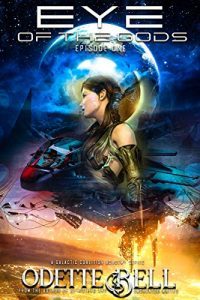 The Eye of the Gods by Odette C. Bell:
The Eye of the Gods by Odette C. Bell:
Vivian Bond has a secret that could bring down the Milky Way. Special Commander Jake Trace doesn’t care – he hates her.
When Jake meets the irritating Vivian at a gallery, and she steals a painting he’s been tasked to secure for his superiors, he locks onto her like a hunter to prey.
It’s the only thing that saves her life. For Vivian Bond has enemies. Everywhere. She has a twisted destiny she’s run from her whole life. Now it will catch up.
Vivian and Jake are thrown together in a fight for the Milky Way and beyond as an ancient power rises once more.
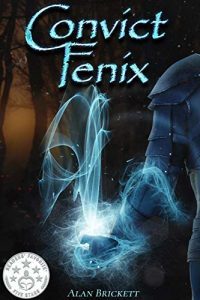 Convict Fenix by Alan Brickett:
Convict Fenix by Alan Brickett:
Exiled to the most secure prison in the realms for a crime he really, certainly, undoubtedly did commit, Fenix must overcome the amnesia all convicts are magically infected with to survive long enough to enact his forgotten plan for escape.
All prisoners have their memory wiped when they arrive, no matter the being, creature or monster they may have been. Most skills are lost and only instinct remains. Fenix’s instinct is survival, and an overpowering need to escape, somehow driven by the slimmest of chances that he can…
The prison is an amalgamation of landscapes smacked together hodgepodge in its own pocket dimension, each piece of it floating around the giant creature that carries it through space and time. There is no escape because there is no way out.
The door only drops people in.
It is the cosmic penal colony where the worst beings in the universe spend their life sentences.
If you do not get executed, you get sent here, which means someone really wanted you to suffer.
Fenix has a plan, or he did before he was imprisoned, the problem is that he must regain his memories quickly enough to make his plan work for him.
What if being a hero was encoded in your genes?
And nobody told you?
Casmir Dabrowski would laugh if someone asked him that. After all, he had to build a robot to protect himself from bullies when he was in school.
Fortunately, life is a little better these days. He’s an accomplished robotics engineer, a respected professor, and he almost never gets picked on in the lunchroom. But he’s positive heroics are for other people.
Until robot assassins stride onto campus and try to kill him.
Forced to flee the work he loves and the only home he’s ever known, Casmir catches the first ship into space, where he hopes to buy time to figure out who wants him dead and why. If he can’t, he’ll never be able to return home.
But he soon finds himself entangled with bounty hunters, mercenaries, and pirates, including the most feared criminal in the Star Kingdom: Captain Tenebris Rache.
Rache could snap his spine with one cybernetically enhanced finger, but he may be the only person with the answer Casmir desperately needs:
What in his genes is worth killing for?
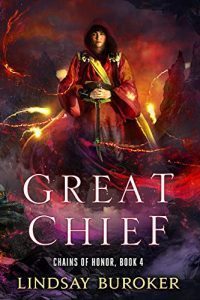 Great Chief by Lindsay Buroker:
Great Chief by Lindsay Buroker:
Yanko White Fox is used to expectations.
Since he was a small boy, his father has expected him to become a powerful mage and redeem his family’s honor. Even if his heart was elsewhere, Yanko always accepted his responsibility. He’s learned all he can about magic, practiced to become powerful, and fought great evil to free thousands of imprisoned people.
But it’s not enough.
Prince Zirabo tasks him with claiming a new land for their nation and keeping it out of the hands of all those who covet it. Even though Yanko has a few good friends to help him, he’s daunted by the enormity of the task. But securing the continent and turning it into a lush farmland may be the only way to end the civil war at home and bring peace to people who are hungry, beleaguered, and divided.
Yanko will have to use all of his power and draw upon everything he’s learned to succeed and bring peace to his war-torn nation. If he can’t, he’ll lose his home, his family, and all that he loves.
A few new problems. One big mystery. A whole new struggle.
While Ben fights to survive the gloomy bowels of Sarcon’s dungeon prison, Tawny navigates the endless bickering of the Sarconan courts to free him. After their efforts meet with failure, it seems the whole world is against them … until an old ally makes her appearance.
But even bigger problems loom.
Enjoying their newfound freedom, they soon realize a mysterious new presence has arisen amongst the Solar Twin System, and it has one purpose: Destroy Tawny and Ben Dash.
With no one to turn to and nowhere to hide, they find themselves in a race against time to discover what this new foe is and unravel its systematic plot to destroy everything they love … before it rips them apart.
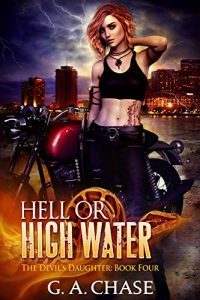 Hell or High Water by G.A. Chase:
Hell or High Water by G.A. Chase:
A light conversation over coffee tosses the devil’s daughter out of the frying pan of life’s problems and into the fiery depths of hell.
Sere Mal-Laurette was warned against meeting Jennifer, the real woman behind her doppelgänger body. However, she didn’t mention that instruction to Jennifer during their numerous psychically bonded moments. So when Jennifer shows up in front of Sere’s apartment, the doppelgänger doesn’t see much choice other than to invite the housewife in for a cup of coffee.
Before the day is out, Myles’s sweet little dog has turned into a hellhound, Sere’s friend and sidekick Fisher has succumbed to his demonic possession, and supersized crawfish have emerged from the swamp. Sere is forced to wonder if she should have heeded the warnings about Jennifer. But is the widening of the hell mouth a result of one morning’s coffee conversation, or is something more sinister at work?
Sere has plenty of other explanations to choose from. There are the lost souls of the damned that Marjory Laroque cast into hell in her attempt to raise a new devil. There’s the fact that Sere’s sweet angel and mother figure, Sanguine, has been imprisoned. Worst of all, Sere’s very presence among the living could be the cause of the impending apocalypse. Once again she needs help curbing the chaos, but this time, she’ll call on her support system in hell.
Tax season. It’s all forms and games until someone loses a murderer.
Authorities have abandoned the search for a sadistic serial killer with a grudge against Zita Garcia’s family. Never one to sit still, the sometime superhero and reluctant tax preparer will do whatever it takes to find him.
With her loved ones at stake, she’ll call in her best friends and questionable new allies to help. If finding her quarry means Zita has to fight literal monsters, wrangle glitter-obsessed vampires, or go to a nightclub, she’ll do it. Even if the undead and line dances make her skin crawl. She needs to get her mask on and solve this fast—before things go from bad to hearse.
A shovel to get through the three feet of snow wouldn’t hurt either.
Monster is the fourth book in the Arca superhero urban fantasy series and includes immoderate language, lame sexual innuendo, and comic book violence.
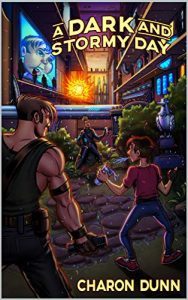 A Dark and Stormy Day by Charon Dunn:
A Dark and Stormy Day by Charon Dunn:
3748 crashes to a halt as Sonny Knight visits Times Square to ring in the New Year.
He’s a little sad because his girlfriend – one of the terrorist clones holding his family prisoner (but she’s one of the nicer ones) – has dumped him. Or maybe she’s being held prisoner by a different band of terrorists, and would appreciate being rescued?
Sonny’s going to have to pull himself together if he’s going to help her. He needs to deal with his grief issues, residual anxiety from everything that happened to him in the last two books, and a blossoming substance problem. Then there’s his fresh anxiety from all the new and exciting dangers that befall him in this one.
Which include more pliosaurs, explosions, avalanches, crowds, true love, assault, battery … the usual.
This is the conclusion of the Adventures of Sonny Knight trilogy.
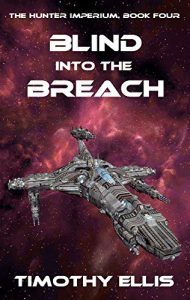 Blind into the Breach by Timothy Ellis:
Blind into the Breach by Timothy Ellis:
Christopher Ecclestone has lived in the dark for a long time.
As a fighter pilot on the old Ark Royal, on the very day all his wishes came true, fate took them away again.
Seven years later, all he can do is listen, as a galactic core wide war begins.
Only the brand new Imperium had space fighters, and they were a liability, not an asset.
Now the Trixone have them, they’ve swept their frontier clean, and invaded Ralnor and Keerah space.
The Ralnor asked the fledgling Imperium for help.
But the Imperium only has a small number of fighter pilots, with nearly half being rookies without a combat launch to their names. And half of the veterans are flying a brand new untested carrier based fighter.
How do you keep an outnumbered force of veterans and rookies alive, when the enemy has a new weapon no-one knows anything about? Are the Imperium’s fighters even a match?
With the need for every available pilot, Jane walks into Chris’s life, gives him back what he lost, and recruits him to join the fighter wing on Orion’s Belt.
The legend of Dreamwalker has begun, with Orion’s Belt jumping Blind into the Breach.
A mutineer fleet commander. An abandoned miner. A reformer’s widow. A convicted Protector.
Four destinies. One empire.
From the frozen prison planets to the glistening streets of Central, corruption and cruelty is tearing the Tribari Empire apart. Four unlikely heroes find themselves on a collision course as they work to save their worlds. If they can’t find a way to bridge their differences, there may be no empire left to protect.
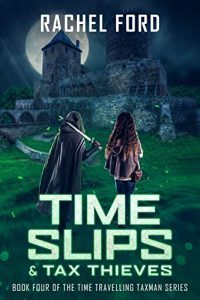 Time Slips & Tax Thieves by Rachel Ford:
Time Slips & Tax Thieves by Rachel Ford:
A simple mistake. A slip through time and space. A strange new world.
He should have been more careful. But Alfred Favero, Senior Analyst with the IRS, wasn’t. Now he’s stuck in a world of opposites, where everything he knows is called into question.
To survive in Yngil-wode, the taxman must rely on a mysterious band of outlaws and tax thieves. But he risks getting drawn into a war with a tyrant. He risks sacrificing every principle he holds sacred.
How far will a man of the law go to save his own neck? How far will he go to save the woman he loves? Alfred’s about to find out.
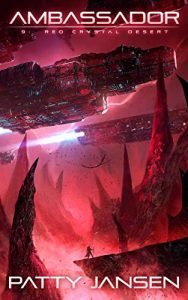 Red Crystal Desert by Patty Jansen:
Red Crystal Desert by Patty Jansen:
The conflict has brewed for generations, until it has become too big to handle.
Cory and his association finally return to Asto on the invitation of his father-in-law, for his official induction ceremony into the Domiri clan. They are housed in a magnificent villa overlooking a valley, away from the hustle of cities or the military base.
But why can’t they stay with their host? Is it for security? Is it because their host fears upsetting his household?
With Thayu heavily pregnant, Cory has no appetite for adventures. But something is brewing, and listening bugs, a nightly attack and invasion are all part of the deal.
Wouldn’t it be nice if for once Asto’s elite was upfront about the nature of the problem?
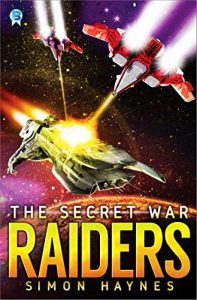 Raiders: The Secret War by Simon Haynes:
Raiders: The Secret War by Simon Haynes:
Everyone has been scarred by the war, and Sam Willet is no exception.
Sam is convinced she has what it takes to become a fighter pilot… to hunt down and destroy the enemy in deep space.
Instead she’s assigned to Tactical Operations training. It’s vital work, but it’s still a desk job, far from the front line.
Then, terrible news: Sam’s older brother is killed in combat.
Sam is given leave to attend his memorial service, but she’s barely boarded the transport when the enemy launches a surprise attack, striking far behind friendly lines to take the entire sector.
Desperately short of pilots, the transport’s captain asks Sam to step up.
Now, at last, she has the chance to prove herself.
But will that chance end in death… or glory?
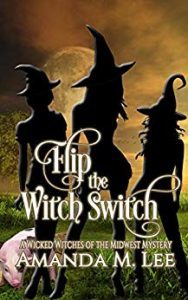 Flip the Witch Switch by Amanda M. Lee:
Flip the Witch Switch by Amanda M. Lee:
Bay Winchester and Landon Michaels are looking for a romantic outing, revisiting the past now that they know they met as children. That trip leads them to the camp they visited back in the day … and to a new adventure.
It’s a happy excursion down memory lane until they happen upon the old pool and discover a hand poking out of an ancient cover. That means their day off becomes an official investigation.
Once identification comes through, Bay starts digging … and hard … to find out why a young woman writing a book would go missing in Hemlock Cove. The information she finds is disturbing … and the answers to the present case may come from the past, and a long-forgotten missing person’s case.
There’s a lot going on. Mrs. Little is trying to buy the property and wants the crime kept secret, which means Aunt Tillie is on a rampage to make sure her mortal enemy doesn’t win … even if the prize is something she doesn’t really want.
The Winchester witches are in turmoil. The local police chief is officially dating Bay’s mother, one of their own is keeping a huge secret, and they have a wedding coming up so that means dress fittings and place setting decisions galore.
Bay is on deck and has to figure it all out. She’s going to need help to do it. Even then, with her team in place, she might not come out on the winning side.
There’s a killer hiding in the shadows and death is coming. It’s going to take everyone working together to uncover the truth.
Can they pull it off?
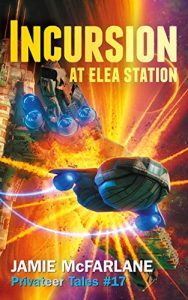 Incursion at Elea Station by Jamie McFarlane:
Incursion at Elea Station by Jamie McFarlane:
An alien invasion. A home-world destroyed. Can an embattled captain survive a daring fight to save the remnant of his colony?
Privateer Liam Hoffen can’t wait to reunite with his family. But after he emerges from a 20-year stasis, he’s shocked to discover a hostile enemy has razed his home and exiled his people. With his foes dependent on a gas-mining platform to keep their ships fueled, Liam’s last-ditch hope is to cut off the vicious aliens with the help of a brother he never knew he had…
Armed only with ancient combat-damaged clunkers, he and his stubborn sibling must lead a dangerous assault on the enemy’s critical resources. Grossly outnumbered and far from reinforcements, Liam fears he’ll have to put everything on the line to defend the people he loves from annihilation.
Can Liam stop the powerful adversary from killing his family and taking over the system?
Incursion at Elea Station is the 17th standalone book in the epic Privateer Tales space opera saga. If you like intergalactic crusades, spirited sibling rivalry, and underdog heroes, then you’ll love Jamie McFarlane’s riveting sci-fi adventure.
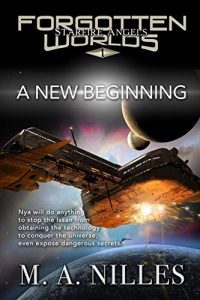 A New Beginning by M.A. Nilles:
A New Beginning by M.A. Nilles:
On a remote mining station, Nyalin hides a secret that would make her a hunted woman—she is a Crystal Keeper, a protector of a shard of the powerful Starfire crystal. However, when a strange shuttle falls through a portal near the mining station, she can no longer avoid her responsibilities. The human pilot, Vellin, is part of a research team that has developed gateways for instant travel anywhere in the universe without requiring a Starfire crystal, and he has been followed by an enemy through the portal.
To stop dangerous forces from possessing the gateways to spread destruction, Nya must team up with Vel and risk exposing her secret. In their race to destroy the gateways, they will find allies and enemies… and a new reason to worry.
Mari Yosoto has been keeping a dark and dangerous secret from everyone for the past three years. No one would believe her anyway, her ex-fiancé had seen to that. Instead of wallowing in misery, she stays busy, shuttling cargo to the Moon and back, enjoying the easy work and time alone. An old EarthCorps acquaintance asks for her help, and Mari can’t say no, even if it means working with the ex’s former best friend.
Although Trevor Nash took the missing person’s job to help his former commanding officer, deep down he needed to see Mari again. After trying and failing to find out what happened to her, Trevor makes the best of an odd situation, hoping he can remind Mari of their budding friendship and finally get some answers. When the mission goes sideways and they find the not-so-missing girl, a centuries-old conspiracy theory comes to light and the only thing more unfathomable is learning Mari’s secret.
Together with their newly formed ragtag team, Mari and Trevor team up and undertake a mission unlike anything either of them has faced before with life-altering and possibly deadly consequences.
[image error] Condor Rising by Jaxon Reed:
The Republic has a new type of ship. The Condor-class is huge, deadly, and carries a secret weapon.
One spy has all the details, but he’s trapped and unable to share with his handler. She sets the wheels in motion to get him to Lute, the pirate stronghold, where they can meet and freely transfer information.
As the League gathers an overwhelming force to take Gotha Mu, the tiny golden planet in the Seychar system, Captain Christopher Raleigh and his crew race to prevent League spies from leaking the surprise in store for them.
Action, thrills, spies, gadgets, and deception await in this third installment of the Pirates of the Milky Way saga!
 How to Hire a Vampire Consultant by Hollis Shiloh:
How to Hire a Vampire Consultant by Hollis Shiloh:
Steve isn’t used to being the responsible party. He’s not even a real agent at the Paranormal Research Agency—he’s here on parole. But right now, a lot of the PRA’s people are missing, and Steve and the librarian might be the only ones who can save them. While she researches like her life depends on it, Steve’s running around mopping up monstrous messes. He needs all the help he can get—even from a sassy vampire. Barnaby the vampire is kind of hot (for a twink), and not nearly as badass as he likes to think. Even if he did save Steve’s life. Between the three of them, they might just have what it takes to save the day.
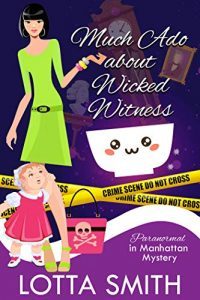 Much Ado about Wicked Witness by Lotta Smith:
Much Ado about Wicked Witness by Lotta Smith:
A tricky art theft and talking teacup… Throw in a perky ghost and a perkier toddler!
When a slightly tricky art theft takes place in an upscale Upper East Side neighborhood, Mandy and Rick are called in to crack the case.
With their daughter Sophie and Mandy’s ghost pal Jackie in tow, the USCAB duo tackle a baffling switcheroo. An art dealer’s pricey Japanese vase has been replaced with a cheap fake and an attempted murder complicates the situation. The only witness: a talking teacup. Can Mandy coax the spirit of an ancient Samurai with a fuzzy memory to spill the tea on who nabbed the Shino while wrangling a demanding toddler and wrestling with worry about taking a baby to a crime scene?
Join the Rowling clan as they attempt to literally save the Day in the latest adventure of the Manhattan Mystery series.
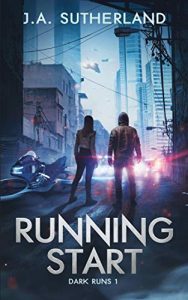 Running Start by J.A. Sutherland:
Running Start by J.A. Sutherland:
What if you discovered you’d been sold?
For Mason Guthrie, a sudden arrest, railroad trial, and quick conviction for the “vandalism” of fixing things around his tenement building come as a shock.
For Rosa Fuentes, it’s just more confirmation that, to Earth’s rulers, they’re nothing but commodities to be bought and sold.
Together — along with Rosa’s disturbingly capable AI — they break out and make their way off Earth to start a new, free life.
Unfortunately, the folks they stole a billion credits from along the way would like those back.
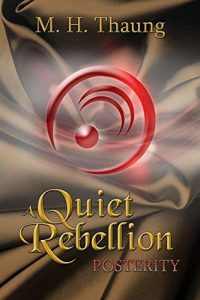 A Quiet Rebellion: Posterity by M.H. Thaung:
A Quiet Rebellion: Posterity by M.H. Thaung:
In a land where paranormal powers are transmissible, but their recipients condemned as a threat to society, Queen Eleanor struggles to improve life for all her subjects including the afflicted. Rocked by a recent betrayal and disillusioned by her late father’s secret scheming, she fabricates threats of an external attack to push for social reform.
Her ploy meets with initial success, easing her guilt about misleading the entire realm. However, evidence comes from an unlikely source that the threat is real. The realm must prepare for war, and Eleanor stands to lose everything she has fought for.
This is the final book in the Numoeath trilogy.
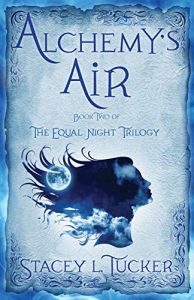 Alchemy’s Air by Stacey L. Tucker:
Alchemy’s Air by Stacey L. Tucker:
Skylar Southmartin is not the naïve girl she was a short year ago. She’s made some mistakes and learned a few secrets to life, all the while clinging to the faith her mother instilled in her as a child . . . in herself. And now that she has discovered her life’s purpose within the pages of the ancient Book of Sophia, she knows what she must do: restore a vital memory to the Akashic Library, located deep within the Underworld of Earth. This library is sought after by many who are aware of its existence, for they know the future of human potential rests at its core.
Meanwhile, Devlin Grayer has been elected as the 46th President of the United States and his wife, Milicent, is miserable in her new role as First Lady—especially because the Great Mothers have asked Milicent to use her new status to help their cause, and she has no interest in tackling that task.
With the help of friends in the unlikeliest of places, Skylar’s journey reveals the significance of the darkness within all of us, and its potential to save or destroy the most precious part of us all: our soul.
 The Tide of War by Lori A. Witt:
The Tide of War by Lori A. Witt:
Lieutenant Commander Kyle West is one of Unified Fleet’s greatest fighter pilots. Every day, he leads his squadron into battle over Earth’s cities in a seemingly endless war against a vicious alien race, defending his home and his loved ones.
Millions of miles away, the Fleet’s Elite Squadron attacks from another angle, engaging the enemy on its home turf. Casualties are high, and the Squadron needs more of the Fleet’s very best. But joining the Elite is a death sentence—a surety Kyle isn’t willing to face. Until a devastating attack wipes out the family he refused to leave.
Commander Andrei Dezhnyov, an Elite Squadron gunner, isn’t sure what to make of the cocky new American pilot. Kyle is equally uncertain about the snarly Russian, but as they warm up to each other, their tentative alliance becomes a deep bond—one that endangers them both when a daring and disobedient rescue reveals secrets that call into question everything they’ve ever believed about their enemy. Secrets that their superiors would kill to protect.
 Send to Kindle
Send to Kindle
May 29, 2019
Indie Crime Fiction of the Month for May 2019
 Welcome to the latest edition of “Indie Crime Fiction of the Month”.
Welcome to the latest edition of “Indie Crime Fiction of the Month”.
So what is “Indie Crime Fiction of the Month”? It’s a round-up of speculative fiction by indie authors newly published this month, though some April books I missed the last time around snuck in as well. The books are arranged in alphabetical order by author. So far, most links only go to Amazon.com, though I may add other retailers for future editions.
Our new releases cover the broad spectrum of crime fiction. We have cozy mysteries, small town mysteries, animal mysteries, historical mysteries, hard boiled mysteries, paranormal mysteries, crime thrillers, psychological thrillers, paranormal thrillers, romantic suspense, noir fiction, private investigators, amateur sleuths, ex-cons, precognitives, serial killers, missing persons, heists, crime-busting witches, crime-busting fashion photographers, crime-busting cats and crime-busting ghosts, a surfeit of puppies, murders in small towns and big cities, on theatre stages and aboard cruise ships, in 18th century Venice, contemporary New York City, Glasgow, New Orleans, Las Vegas, North Carolina, New Mexico and much more.
Don’t forget that Indie Crime Fiction of the Month is also crossposted to the Indie Crime Scene, a group blog which features new release spotlights, guest posts, interviews and link round-ups regarding all things crime fiction several times per week.
As always, I know the authors at least vaguely, but I haven’t read all of the books, so Caveat emptor.
And now on to the books without further ado:
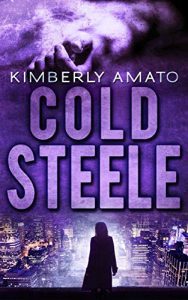 Cold Steele by Kimberly Amato:
Cold Steele by Kimberly Amato:
A SERIAL KILLER IS SAYING IT WITH FLOWERS…
In the fourth installment of Kimberly Amato’s chilling hard-boiled mystery series, badass detective Jasmine Steele is back — and shockingly, to herself most of all — she’s as happy as she’s ever been.
She and her brilliant psychologist partner Frankie are planning a wedding that’s been years in the making, and she’s settled into a new chapter of life with her nephew-turned-adopted son, Chase. But the good life turns out to be more fleeting than the detective’s caffeine withdrawals.
Jasmine, or Jazz, to her friends, gets a rude awakening when a 3-year-old cold case comes back hot. New York City’s “Carnation Killer,” a serial rapist and murderer, leaves his fifth calling card on a woman named Emilia Smith. The calling card? A heart-shaped carving into the woman’s chest and a single white carnation.
On the creep spectrum, Jazz puts this killer somewhere between Jack the Ripper and the Zodiac Killer. And her veteran right-hand man is on medical leave.
She’s joined instead by temporary partner Detective Sydney Locke, a welcome new character. Sydney’s pretty green but has a fiery determination and talent for the beat that Jazz recognizes within minutes. Soon enough, they’ve got a mentor/protégé thing going – which certainly comes in handy at their often patriarchal workplace.
And it turns out Jazz and Syd will need that and more when the military gets involved with the investigation — because the victim is none other than the daughter of a high-ranking official, and the brass knows more than they’re saying.
What the team does know is that Emilia’s last night alive was spent at a college bar that sparks Jasmine’ least happy memory – the very same establishment that served as a backdrop to her own early adult years, a past defiled and traumatized by a dangerous man. Just as Jazz is finally ready to be happy, her bone-chilling trauma comes rushing back. And the Carnation Killer is still out there.
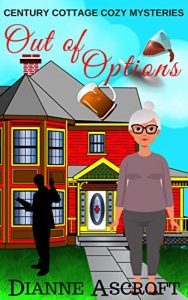 Out of Options by Dianne Ashcroft:
Out of Options by Dianne Ashcroft:
Out of Options is a prequel novella to the Century Cottage Cozy Mysteries series, and introduces Lois Stone and her companions, Raggs and Ribbons, a pair of perceptive calico cats.
A dry district, a shocking secret, a missing person. When Lois Stone’s friend, Beth Darrow, arranges to meet her to reveal an astonishing discovery, Lois’s curiosity is piqued. Then Beth doesn’t keep their lunch date and Lois becomes worried. What has happened to her friend?
Middle-aged widow Lois is settling into life on her own in her neighbourhood and in the library where she works, and she is just about coping with her fear of strangers after her husband was mugged and died in the park at the end of their street. But her quiet existence is rocked when her friend and fellow local historical society researcher, Beth, arranges to meet her to reveal an exciting and shocking discovery she has made about the history of prohibition in West Toronto Junction, the last dry area in Toronto, and then goes missing before she can share her secret with Lois. There isn’t any proof that Beth is missing so the police won’t actively search for her. Only Lois and Beth’s niece Amy are convinced that Beth’s disappearance is very out of character, and they are worried about her. Where has Beth gone? Is she in danger? And, if she is, who might want to harm her and why? Lois knows she must find the answers to these questions fast if she wants to help and protect her friend.
And so begins a weekend of skulking in the park, apple and cinnamon pancakes, familiar faces staring out of old newspapers, calico cats, shadows on the windowpane, and more than one person who might want Beth to disappear from the quiet, leafy streets of the historic and staunchly dry West Toronto Junction neighbourhood.
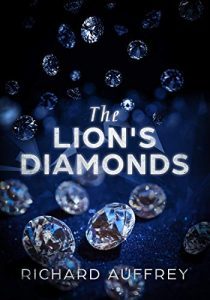 The Lion’s Diamonds by Richard Auffrey:
The Lion’s Diamonds by Richard Auffrey:
Recently released from prison, Leonidas “the Lion” Blackwood is already looking for his next score when a perfect opportunity drops into his lap. To appease his parole officer, Leonidas works at a local church doing general cleaning maintenance. He learns that five million dollars in diamonds will be stored into a safe at the church. Leonidas isn’t a safecracker but he knows the combination to the safe. The heist should be simple. However, complications ensue, and Leonidas is soon on the run, trying to elude Russian gangsters, including a psychotic enforcer. Can Leonidas trust the sultry woman he met in a bar? Can he trust an old friend with whom he shared time in prison? Can he trust anyone? Is there any way that Leonidas can escape with the diamonds to a tropical island?
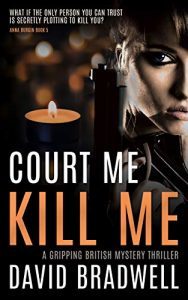 Court Me Kill Me by David Bradwell:
Court Me Kill Me by David Bradwell:
What if the only person you can trust is secretly plotting to kill you?
Fashion photographer Anna Burgin faces a career in ruins after her studio is destroyed, but when armed police burst into her home, she realises it’s the least of her worries.
Murders in Seattle, Frankfurt, Venice and London all point to one common killer – and the chief suspect has just been in her house. The evidence is compelling, the body count is rising, but as news emerges of a corrupt business network that reaches into the heart of the police, nothing can be taken for granted – especially the promises of the person who offers to protect her.
Packed with twists, intrigue and dark humour, Court Me Kill Me is book 5 in the bestselling Anna Burgin series. Read it now.
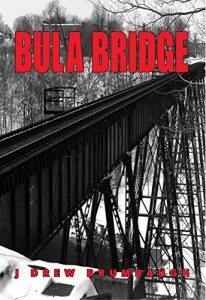 Bula Bridge by J. Drew Brumbaugh:
Bula Bridge by J. Drew Brumbaugh:
The exciting sequel to “War Party.” Tommy has another vision and this one shows a plot that will endanger thousands of innocent people. The only problem is the vision doesn’t provide the exact location, only a railroad bridge that will be destroyed. What can he do?
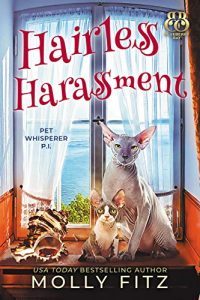 Hairless Harassment by Molly Fitz:
Hairless Harassment by Molly Fitz:
I never signed up to be a private investigator with a snarky, talking cat for a partner, but there’s no backing down now. Especially considering a prominent politician was murdered pretty much right in my backyard.
The only witnesses were the senator’s two hairless cats, Jacques and Jillianne. Normally pets want to help us solve their owner’s murders, but this time it seems the two devious felines might actually be the ones who committed it…
Surprisingly enough, my own partner in crime, Octo-Cat, actually wants to help this time, but he can barely understand our two prime suspects because of their strange Sphynx accents. And I thought speaking tabby was hard!
So, there you have it, even with two successful cases behind me, I really don’t know how I’m going to solve this one. Is it too late to go back and pick another career?
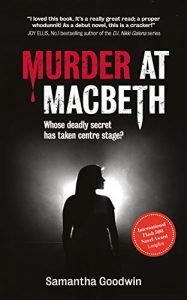 Murder at Macbeth by Samantha Goodwin:
Murder at Macbeth by Samantha Goodwin:
Whose deadly secret has taken centre stage?
When a talented, young actress unwittingly stabs herself live onstage after a prop knife is tampered with, suspicion immediately falls on her eclectic band of castmates. But who had the motive to kill the show’s leading lady?
As the insightful, yet disillusioned, Detective Inspector Finley Robson and his shrewd partner, Detective Sergeant Nadia Zahra, interrogate the seven key suspects, secrets unfold to unveil a web of scandal, blackmail, and deceit. Bitter rivalries, secret trysts and troubled pasts are just the beginning of the story…
Set against the backdrop of a gritty London theatre production of Macbeth, this compelling novel explores a dark world of mystery and intrigue. All is not as it seems…
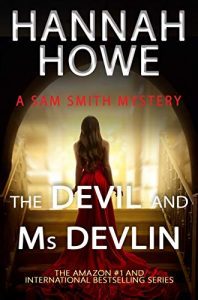 The Devil and Ms. Devlin by Hannah Howe:
The Devil and Ms. Devlin by Hannah Howe:
In her heyday, the critics regarded Dana Devlin as the most beautiful actress in movies. They also regarded her as shallow, lacking emotion. That was strange because Dana Devlin’s life had been a rollercoaster of emotions, with divorces and nervous breakdowns to the fore. And now she was making a comeback, in a gothic romance, Demon Seed.
Everyone’s a critic, it seems, because someone didn’t like the sound of Demon Seed, and they voiced their disapproval through a series of death threats. However, the death threats were covered in hearts, flowers and angels. What was going on?
Demetrios Angelopoulos, Dana’s lover, and the producer of Demon Seed, asked me to investigate the death threats. Meanwhile, I recruited Faye, Mac and Blake to ensure that Ms Devlin came to no harm.
As the cameras rolled, I opened a can of worms, which led to the spilling of secrets and murder. And Dana Devlin? She was about to play her greatest role, a role that would reshape her life.
 Flip the Witch Switch by Amanda M. Lee:
Flip the Witch Switch by Amanda M. Lee:
Bay Winchester and Landon Michaels are looking for a romantic outing, revisiting the past now that they know they met as children. That trip leads them to the camp they visited back in the day … and to a new adventure.
It’s a happy excursion down memory lane until they happen upon the old pool and discover a hand poking out of an ancient cover. That means their day off becomes an official investigation.
Once identification comes through, Bay starts digging … and hard … to find out why a young woman writing a book would go missing in Hemlock Cove. The information she finds is disturbing … and the answers to the present case may come from the past, and a long-forgotten missing person’s case.
There’s a lot going on. Mrs. Little is trying to buy the property and wants the crime kept secret, which means Aunt Tillie is on a rampage to make sure her mortal enemy doesn’t win … even if the prize is something she doesn’t really want.
The Winchester witches are in turmoil. The local police chief is officially dating Bay’s mother, one of their own is keeping a huge secret, and they have a wedding coming up so that means dress fittings and place setting decisions galore.
Bay is on deck and has to figure it all out. She’s going to need help to do it. Even then, with her team in place, she might not come out on the winning side.
There’s a killer hiding in the shadows and death is coming. It’s going to take everyone working together to uncover the truth.
Can they pull it off?
 Jake of All Trades by A.T. Mahon:
Jake of All Trades by A.T. Mahon:
Jake is not long out of prison for violence and takes on any job he can get. He is also a private investigator, though he doesn’t have a license, despite what his fake qualifications state.
Mrs Carson, his ex-teacher, hires him. They despise each other, but they forego their animosities for the sake of the job in hand. She wants him to find a missing schoolgirl by any means possible. In doing so, he comes face to face with perverts, rapists and gangsters.
With little information to go on, he has to cut corners, which includes aggression.
Along the way, he not only discovers the who’s who of the underworld, but also who he really is. It’s a far different picture than the self portrait he had painted of himself.
Things come to a head when he confronts both the antagonists and his own demons.
Violent moneylender Corona Mundt warned Sophie not to come back to Venice, so she shouldn’t be guarding Archduchess Isabella at the Carnival – any more than Isabella should fall for louche, penniless, would-be librettist Larry da Ponte. And once the two of them get together, it’s only a matter of time before Sophie comes face to face with her worst enemy.Serene is the third in a series of novels from the era of Mozart and Maria Theresia.
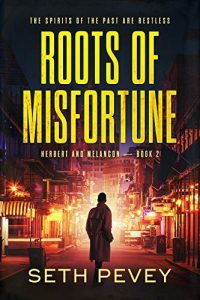 Roots of Misfortune by Seth Pevey:
Roots of Misfortune by Seth Pevey:
The dead girl is holding roots, one grasped tightly in each palm, when the NOPD finds her mangled body out on Interstate 10.
David Melancon has gone independent. The corruption on the force was just too much for an old detective who doesn’t play ball. But there is something eerily familiar about the details of this young girl’s demise as he reads them in the Picayune. Something deeply personal. Something he can’t drink his way past this time.
But he’s got his young and naïve partner, Felix Herbert, to think about. The boy hasn’t even let the ink dry on his newly-minted PI’s license. He just isn’t ready for this kind of case.
Yet, when another girl goes missing the same week, a knock at the door ensures the two unlikely partners won’t have a choice. They soon find themselves entangled in an ever-thickening web of cruelty, violence, and revenge.
As they search for the missing girl, they’ll confront Voodoo priestesses, Mardi Gras Indians, and a secret at the root of things so terrible that, once uncovered, will change David Melancon’s life forever.
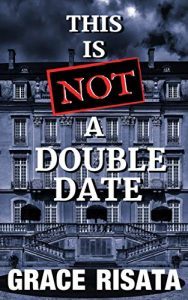 This is Not a Double Date by Grace Risata:
This is Not a Double Date by Grace Risata:
Andi Cartwright is intrigued when her best friend invites her to a concert and insists it is not a set-up. Yes, she’ll be meeting Cara’s new boyfriend and his cousin, but it was made abundantly clear that this is not a double date.
Much to everyone’s surprise, Roman hits it off with Andi. The normally antisocial man recognizes a kindred spirit, and can’t stay away from her no matter how hard he tries.
After a series of group outings including an escape room, family game night, and a food eating competition, it becomes apparent that all is not what it seems.
Once Roman’s true motive is revealed, will Andi be able to put her feelings aside and move on…or will she simply become another victim caught in a web of lies?
This is not your typical ‘boy-meets-girl’ story. With plot twists around every corner and sinister intentions behind seemingly innocent actions, who can really be trusted?
One close-knit family. Too many secrets.
When detective Jack Ryder is going skiing with his family in the mountains of North Carolina, he hopes for a week of fun in the snow with the ones he loves.
But then the body of a teenage boy turns up in the cold waters of the creek behind the cabin they have rented.
Don’t tell or you might be next.
The find shocks the rural community of Maggie Valley and rattles local law enforcement. What happened to the boy is more than strange.
Soon more bodies are found, and Jack Ryder digs into the case that seems to be anything but ordinary. What happened on the night that Benjamin Rutherford disappeared from the porch of his childhood home? Is his father — the local pastor — telling the truth? Is his sister?
As Jack digs deeper into this seemingly perfect family, he begins to wonder if any of them are what they pretend to be and what secrets they are hiding beneath the surface.
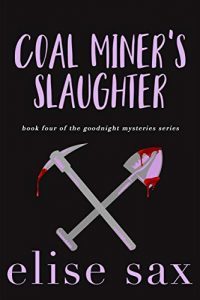 Coal Miner’s Slaughter by Elise Sax:
Coal Miner’s Slaughter by Elise Sax:
Death is following Matilda, and it’s not going unnoticed in the small town of Goodnight, New Mexico. When she finds Inga Mueller, a local jewelry maker, drowned in a bucket of resin, Matilda’s reputation is sealed as the harbinger of death. As she begins to investigate Inga’s murder, she discovers Inga’s darker, secret life with ties to Goodnight’s prominent residents. In order to find the killer, Matilda must unlock the town’s secrets, and the town isn’t happy about it. As she follows the twists and turns of a mystery with a long reach, she’s making enemies and dodging a killer who wants to shut her up.
Coal Miner’s Slaughter is the fourth installment of the funny small town mystery romance Goodnight Mysteries series and a spinoff of the Matchmaker Mysteries.
 Much Ado about Wicked Witness by Lotta Smith:
Much Ado about Wicked Witness by Lotta Smith:
A tricky art theft and talking teacup… Throw in a perky ghost and a perkier toddler!
When a slightly tricky art theft takes place in an upscale Upper East Side neighborhood, Mandy and Rick are called in to crack the case.
With their daughter Sophie and Mandy’s ghost pal Jackie in tow, the USCAB duo tackle a baffling switcheroo. An art dealer’s pricey Japanese vase has been replaced with a cheap fake and an attempted murder complicates the situation. The only witness: a talking teacup. Can Mandy coax the spirit of an ancient Samurai with a fuzzy memory to spill the tea on who nabbed the Shino while wrangling a demanding toddler and wrestling with worry about taking a baby to a crime scene?
Join the Rowling clan as they attempt to literally save the Day in the latest adventure of the Manhattan Mystery series.
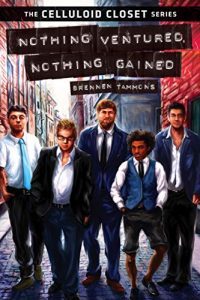 Nothing Ventures, Nothing Gained by Brennen Tammons:
Nothing Ventures, Nothing Gained by Brennen Tammons:
Five men. Five unique personalities. Five different reasons.
In “The Celluloid Closet Series”, “Nothing Ventured, Nothing Gained”, five men embark in an epic journey, full of several twists and turns. This action packed, suspense, thriller, will have you entertained.
A group of men who feel ostracized from society, take on a world of organized crime, each for their own personal agenda. These men who all come from several backgrounds, form a special brotherhood, to obtain the success they seek.
Throughout the adventure, many trials and tribulations will form. These events will test these men to their ultimate potential and self worth. How far will these men go to achieve what they truly want? What risks will they be willing to take along the journey? Will they learn any important lessons along the way?
Keeping in mind, “Nothing Ventured, Nothing Gained.”
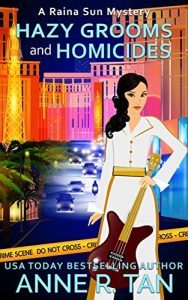 Hazy Grooms and Homicides by Anne R. Tan:
Hazy Grooms and Homicides by Anne R. Tan:
Raina Sun arrives in Las Vegas to elope and ends up with a missing groom. With an overbooked hotel-casino and a rock and roll conference, Raina thought her fiancé was helping the hotel-casino with their security—until a strange woman searches Raina’s room and a dead woman is found in a laundry bag.
And to make matters worse, the security videos show both Raina and her fiancé interacting separately with the dead woman hours before her death. With no communication from her fiancé, Raina fears the worse—he is in hiding. But from whom? And how is he connected to the victim? With the help of the grandmas, can Raina find the killer and track down her fiancé?
Come join Raina, Po Po, and the rest of the gang in Sin City. It’s Vegas, baby! Grab your copy of “Hazy Grooms and Homicides” today!
[image error] Come Find Me by Casper Valentine:
Come find me…
Ever since they were kids playing hide-and-seek, Narcotics Detective Nate Randolph took care of his troubled half-sister. When he discovers her missing one morning, Nate immediately knows something is wrong. As a single mother she’s had her struggles, but Ruby would never run off and leave her baby all alone. Not even before she got clean.
Come find me…
Nate is under no illusions. Each day that passes diminishes the chances of finding his sister alive. But he’s not about to give up. Not when a shred of hope remains to solve her kidnapping. Not when a beautiful colleague offers to help. And definitely not when his sister’s plea echoes day and night in his mind.
Come find me…
When the Narcotics Task Force goes up against the Armenian Mafia, both investigations unexpectedly collide. Explosive revelations that tie past to present push Nate to the edge.
And everything is on the table when a man is desperate.
 Pineapple Puppies by Amy Vansant:
Pineapple Puppies by Amy Vansant:
Puppies have taken over book NINE of the hilarious Pineapple Port mystery series from Wall Street Journal and USA TODAY Best-Selling author Amy Vansant!
Someone has left puppies on the doorsteps of Pineapple Port’s residents, but the adorable balls of fur seem to be connected to the murder of a nearby millionaire with too many heirs of his own. Meanwhile, Mariska’s been framed for baking a killer cake, and Charlotte must clear her name
Fans of classic cozy mysteries will adore this whodunnit packed with puppies, baking, horses, sneaky maids and a dead rich man!
 Beauty Queens and Cruises by A.R. Winters:
Beauty Queens and Cruises by A.R. Winters:
What’s worse than a self-centered beauty queen? A cruise chock full of them!
But what if the self-centred beauty queen is also a murderer?
When the Swan of the Seas hosts a beauty pageant, Adrienne is forced to spend her time dealing with narcissistic judges, oblivious contestants and a feminist protest.
The event seems hectic enough, when Diana Penn, the esteemed beauty queen and headlining judge, is found murdered!
Now, it’s up to Adrienne and her friends Cece, Sam, and First Officer Hot Stuff—er, First Officer Ethan Lee—to sort through the secrets and lies and uncover the truth hiding behind those pristine smiles.
 Send to Kindle
Send to Kindle
May 28, 2019
Dispelling More Misconceptions About the Golden Age
Approximately, two weeks ago I wrote a post about the 1944 Retro Hugo finalists in the novelette category and how those stories show that the so-called Golden Age of science fiction was a lot more diverse than most people assume. I’ve since read/reread more of the 1944 Retro Hugo finalists (I’m alternating between current year and Retro Hugo finalists to avoid overdosing on any particularly style or theme), so here is a follow-up post with more of my observations about the Golden Age and how it doesn’t quite match our ideas of what Golden Age science fiction was like.
My previous post got quite a bit of traction and also inspired this great post by Font Folly, part of a series of posts explaining that science fiction has never been only or primarily for and about straight white cis men and that women, people of colour and LGBT folks have always been part of the SFF community as fans, writers, editors and artists.
On a related note, in this Facebook post Connie Willis also points out that women have always been writing science fiction and lists some women writers of SFF from the 1930s to 1960s she wishes were better remembered (found via File 770).
In my previous posts, I talked about the women who appear on the 1944 Retro Hugo ballot, both as writers and characters, and about the fact that three stories in the novelette category alone feature characters of colour. Two of them have protagonists of colour. There are two more characters of colour in the short story category, by the way, a black barkeeper in Robert Bloch’s “Yours Truly, Jack the Ripper” and Paul, the protagonist of C.L. Moore’s “Doorway into Time” is briefly described as dark-skinned, while his girlfriend Alanna is clearly described as white and blonde, so we even have a mixed race relationship in a story published in 1943. However, I didn’t talk about LGBT characters and creators, because – even though LGBT people absolutely did write and read SFF during the Golden Age and characters implied to be LGBT appeared in Golden Age fiction – there are very few examples on the 1944 Retro Hugo ballot.
Warning: Spoilers for some very old science fiction stories behind the cut!
One exception is Weird Tales cover artist Margaret Brundage, one of the comparatively few female cover artists of the pulp era, who is nominated in the Best Professional Artist category for the 1944 Retro Hugos. Margaret Brundage was married to a man, a marriage which eventually ended in divorce, and I know little else about her private life beyond the fact that she was involved in radical politics. However, her artwork, which is maybe a little too erotic for modern audiences, which may be the reason she has been nominated for a Retro Hugo several times, but never won, tells a different story. For there is a definite lesbian vibe to many of her famous Weird Tales covers.
Oddly enough, I never really noticed this, even though I am a longtime admirer of Ms. Brundage’s work. Until one day, when I read an article about the visual depictions of Conan. The author lamented that even though Margaret Brundage did the covers for several Weird Tales issues featuring Conan stories, she only depicted Conan himself three times and never as impressive as the author of the article would have liked to see him. Margaret Brundage, the author lamented, simply seemed to like painting naked women and rarely portrayed men in a heroic way. And as I looked at the covers, the scales fell off my eyes and I thought, “Crap, he’s right.” For the vast majority of Margaret Brundage’s covers for Weird Tales feature only women, either alone or with other women, animals (here is another), statues (here is another classic woman with statue cover by Margaret Brundage) or monsters. If men show up in those covers at all, they are usually torturers (here is another), executioners (not actually a Solomon Kane cover, though I always assumed it was), kidnappers. otherwise sinister figures or in need of rescue (this is actually Conan, though not as most people imagine him). Margaret Brundage simply wasn’t very interested in drawing men, particularly conventionally attractive and heroic men.
Moving away from artists, let’s take a look at writers and characters. Font Folly mentions Edgar Pangborn, Jim Kepner and Edythe Eyde a.k.a. Lisa Ben a.k.a Tigrina as LGBT fans and writers who were active during the Golden Age. Arthur C. Clarke would be another name to mention for this era.
Looking at characters, there is a definite gay vibe to the relationship between Seabury Quinn‘s occult detective Jules de Grandin and his Watson analogue Dr. Trowbridge, more so than I ever got from Holmes and Watson. Of course, Margaret Brundage, who provided the cover art for several Jules de Grandin stories, usually used them as an excuse to portray yet more scantily clad women, since she was no more interested in drawing Jules de Grandin than she was interested in drawing Conan (and indeed it’s fascinating that Weird Tales‘ most famous characters are never actually seen on the covers). But Seabury Quinn was happy enough to oblige and inserted respective scenes featuring scantily clad young ladies in his stories. But then I suspect that Margaret Brundage was more interested in the female characters of the Jules de Grandin stories than de Grandin himself. Meanwhile, Seabury Quinn’s novel Alien Flesh, written in 1950, but published posthumously in 1970 and actually based on one of his short stories for Weird Tales, features a man approaching a (male) childhood friend after he has been magically changed into an attractive young woman. Naturally, they fall in love. As we will see, magical sex changes were a thing during the Golden Age.
Alas, Seabury Quinn spent WWII as a lawyer working for the US government and therefore has no stories on the 1944 Retro Hugo ballot. However, we do find an example of what is probably the greatest bromance in the SFF genre on the 1944 Retro Hugo ballot, namely “Thieves’ House”, one of Fritz Leiber’s Fafhrd and Gray Mouser stories.
Now Fafhrd and the Gray Mouser are clearly the most important person in each other’s lives, more important than their respective lovers (of which there are many), parents (okay, so only Fafhrd has parents; Mouser is an orphan) or – late in the series – children. They met by chance on the streets of Lankhmar, when they both tried to rob the same thief, and fell in friendship at first sight. On that same night, they lost everything – for the second time in the space of a few months* – and have been inseparable ever since. But are Fafhrd and Gray Mouser truly just friends or is there more?
We do have a definite answer to this question, courtesy of one who should know, namely Fritz Leiber himself. For in “The Mouser Goes Below”, last of the Fafhrd and Gray Mouser stories, published in 1988, Mouser chances to observe his on and off lover, the rat princess Hisvet, engaging in some lesbian BDSM play, which would have had Margaret Brundage leap at the chance of illustrating the scene, if she hadn’t died twelve years before.
Watching this scene, the Gray Mouser muses that same sex attraction makes absolute sense to him and wonders why Fafhrd and he never seemed to have experienced anything like that. He also wonders whether it’s actually unusual not to be attracted to the same sex at least on occasion. So yes, they really are just very good friends (and I suspect that Leiber ran across some fanfic and decided to settle the question once and for all), but it would have been perfectly okay, if there had been more .
Of course, “The Mouser Goes Below” was published in 1988, a much more liberated time than the 1940s. And indeed, there are quite a few mentions in the later Fafhrd and Gray Mouser stories from the 1970s and 1980s that LGBT people not only exist in Nehwon, but are also accepted. Since Leiber was a straight man, he is more interested in lesbian relationships (and the lesbian scenes feel like something out of a 1950s sleaze paperback and were not exactly progressive for the 1970s/80s, but then these late stories were the work of a man in his 60s and 70s), but there is one supporting character in the latter stories who is hinted to be gay.
Compared to the later Fafhrd and Gray Mouser stories, the early stories, which appeared in Unknown Worlds between 1939 and 1943, have no sexual content at all. There also are only three female characters in five stories, two of them unnamed. Even Fafhrd and Mouser are celibate in those stories, which they are definitely not in the later stories (and Leiber actually had to come up with an explanation why Fafhrd and Mouser show no interest in women in those early stories for the fix-up collections of the 1970s). But then, those stories were published by that well-known homophobe and sexphobe John W. Campbell, so Leiber may well have been bowing to editorial pressure.
However, there is one Fafhrd and Gray Mouser story, which dates from the same period as the Unknown stories, but was not published by John W. Campbell. In many ways, “Adept’s Gambit” is the odd one out among the many Fafhrd and Gray Mouser stories, because it’s the only one that is set in our world rather than Nehwon. It’s also the earliest story and was written sometime in the 1930s, even though it was not published until 1949 in the Arkham House collection Night’s Black Agents in 1949. Since only a handful of copies of Night’s Black Agents exist, it is difficult to determine how much later reprints have been revised. S.T. Joshi recently dug up an even earlier draft of “Adept’s Gambit” from the 1930s, but he is mainly interested in H.P. Lovecraft’s influence on Leiber and not in the inclusion of LGBT characters.
“Adept’s Gambit” is a curious story, which still shows some beginning writer issues such as a lengthy flashback in the middle, and quite a few people don’t like it. However, it’s also closer to what Leiber would have written, when not catering to Campbell’s rather puritanical tastes. But what really struck me about “Adept’s Gambit” is that it not only mentions that gay people exist and that there is nothing wrong with that, though Fafhrd personally isn’t interested in young men propositioning him (and since Leiber was from a family of actors – his father Fritz Leiber Sr. is actually in one of the Best Dramatic Presentation finalists for the 1944 Retro Hugos – he likely know quite a few LGBT folks), but that the story also mentions that trans people exist. For both Fafhrd and Mouser fall for the same woman in the story (as happened to them a few times), only that Mouser suspects that she may be a transwoman and wonders whether that would even matter to him at all. In the end, it turns out that the lady in question is magically swapping bodies with her twin brother, so we have another example of a magical sex change. Of course, these magical sex change stories seem corny to modern readers, but I suspect that this was the only way authors could write about such issues at all at the time.
But even though John W. Campbell’s tastes ran towards the puritanical, some authors managed to sneak sex scenes past him. Fritz Leiber snuck some reference to (married) sex into Conjure Wife. And C.L. Moore managed to sneak a sex scene past Campbell at least twice in 1943, once on her own in Judgment Night and once together with her husband Henry Kuttner in Clash by Night. The sex is mild by contemporary standards and definitely heterosexual. But then, even the notoriously racy Spicy pulps are remarkably tame by modern standards and the most risqué thing in those pages are usually extensive descriptions of attractive young women losing their clothes.
Both Judgment Night and Clash by Night are unusual stories, not just for Astounding Science Fiction (and indeed, I had to doublecheck that they were indeed published in Astounding, cause they feel more like what you’d find in Planet Stories), but for the Golden Age in general. Clash by Night, a 1944 Retro Hugo finalist in the novella category, is basically military science fiction, though published sixteen years before Starship Troopers, which is considered the birth of military SF as a separate subgenre. The protagonist Brian Scott is an officer in a mercenary company which fights the endless and largely futile battles between rivalling undersea cities on Venus, after Earth has been destroyed in an all-encompassing nuclear war (another unusual subject for 1943, where the atom bomb was eagerly awaited rather than feared). Scott wants to give up the mercenary life and settle in one of the undersea cities, but after much soul searching decides that he is a soldier first and foremost. Another thing that makes Clash by Night unusual for a story from the early 1940s is that the mercenaries live in open relationships called “free marriages”. Scott’s soul searching whether to remain a mercenary or settle in one of the undersea cities is manifested through his relationships with two women, Jeana, the woman with whom Scott is in an open relationship, and Ilene, an aristocratic city girl who mixes some mean cocktails. When Scott announces his intention to settle with Ilene in the city, Jeana is unfazed and predicts that he’ll return to her in the end. She remains right. If I hadn’t known that Clash by Night was a Kuttner/Moore story from the early 1940s, I might easily have mistaken it for a lesser known Heinlein story from the late 1950s or early 1960s.
Judgment Night, which sadly missed the 1944 Retro Hugo ballot (honestly, people nominated crap like The Weapon Makers or Perelandra over this?), is unabashed space opera. The protagonist Juille is the daughter of the galactic emperor (galactic empires were beginning to become a thing in the 1940s – see also the early Foundation stories) and a warrior woman in the mould of C.L. Moore’s famous creation Jirel of Joiry. She spends much of the novel locked in a love/hate relationship with Egide, the leader of a rebel force threatening her empire, which again parallels the experiences of Jirel of Joiry, who also fell in love with an enemy knight and even traveled into hell itself to save him. In the end, Juille gets her man, but unfortunately the human race is largely destroyed in the process. So here we have a science fiction romance with a female protagonist that ends with the human race being destroyed courtesy of alien superweapons. I couldn’t imagine a less likely story to be published by John W. Campbell in Astounding.
And in fact, I find that quite a few of the 1944 Retro Hugo finalists that were first published in Astounding subvert Campbell’s famous dictum that humanity must always triumph, which suggests that plenty of authors were tired of inevitably having the humans win even as early as 1943. In “Death Sentence”, Isaac Asimov gives us a (very obscure) story in which humans triumph, except that they’re actually sentient robots. In “Attitude”, the Retro Hugo finalist which is probably closest to what one would expect an early 1940s Astounding story to be like, Hal Clement has the humans use their ingenuity to escape the aliens who have imprisoned them only to reveal that the aliens deliberately left the humans to their own devices to see what they would do. And in C.L. Moore’s Judgment Night, love triumphs, but humanity is destroyed anyway. John W. Campbell may have insisted on humans always winning, but his writers clearly had other ideas.
*All this happens in “Ill Met in Lankhmar”, winner of the 1970 Hugo award for best novella, which you should absolutely read.
 Send to Kindle
Send to Kindle
May 23, 2019
Some Reactions to the 2018 Nebula Award Winners and a Post-mortem on the 20Booksto50K Issue
The first reactions to the 2018 Nebula Award winners are pouring in. For my own take, see this post.
Lela E. Buis has a brief post listing the Nebula winners, but in the comments she expresses some concern that Mary Robinette Kowal, whose The Calculating Stars won in the best novel category, was just elected president of the SFWA, which according to Lela is a conflict of interest. I do see the potential issue here. However, Mary Robinette Kowal wasn’t yet president of the SFWA, when the nominations came out. And besides, the SFWA doesn’t seem to have any rules about officers being excluded from the Nebula Awards. In fact, the previous SFWA president Cat Rambo was nominated for a Nebula Award in 2017, while she was president of the SFWA, and graciously withdrew, when it turned out after the nominations came out that the story in question was a few hundred words too short to count as a novelette and would have to be relegated to the short story category, kicking another work off the ballot. Besides, The Calculating Stars is a popular novel, which got a lot of buzz last year, and is a Hugo finalist as well. It’s hardly an unlikely winner.
However, the main cause of debate about this year’s Nebula Award finalists was the 20Booksto50K not-a-slate (for more about this, see my posts here, here and here). Therefore, the reactions from members of that group to none of them winning were bound to be interesting.
Luckily, Camestros Felapton has dug up a post by Craig Martelle at the 20Booksto50K Facebook group about the Nebulas and reposted the most relevant bits for those of us who are not 20Booksto50K members. Of course, Craig Martelle was not nominated himself, but he did edit the anthology where one of the nominated stories appeared, so he is at least tangentially involved. Plus, Craig Martelle also runs the 20Booksto50K Facebook group.
Most of Martelle’s post seems to be extolling the virtues of the 20Booksto50K group and the idea behind it which was developed by Martelle’s business partner and occasional collaborator Michael Anderle. For those who don’t know, the basic idea behind 20Booksto50K is is basically “write fast, publish fast and create a ‘minimum viable product’ in highly commercial genres”. For more information, you can also read their manifesto or watch videos of their conferences. They also have a Wiki with more background information here.
Now I don’t have a problem with either the 20Booksto50K group or their system. I don’t doubt that the group or their conferences help a lot of indie writers. And while their approach to writing and publishing isn’t mine, there are a nuggets of useful information in there.
Alas, the rest of the Martelle’s post engages in same tired “indie versus traditional publishing” rheotric that we’ve been hearing since 2010. “Traditional publishing is slow” – yes, it is, because their model is different, but that doesn’t make it bad. “Awards don’t matter, but whether stories resonate with readers does” – okay, so why are you so desperate to win an award then?
The excerpt from Martelle’s post quoted by Camestros also makes it very clear that Martelle is pretty disgruntled that none of the six 20Booksto50K finalists won. Of course, Martelle claims that he doesn’t want to put down any of the winners, but then he promptly does by implying that the winners aren’t professional enough, because they are not full-time writers. Never mind that SFWA is an organisation for professional writers, so anybody who is a full member is a professional writer by SFWA criteria, whether they are full-time writers or not. And looking at this year’s Nebula winners, Aliette de Bodard and Tomi Adeyemi are full-time writers, as far as I know. Mary Robinette Kowal’s other job is puppeteer, i.e. a career that’s not known for high income or job security. In fact, it’s likely that her writing is subsidising her puppeteering. I have no idea about P. Djèlí Clark and Brooke Bolander nor does it matter. Because plenty of excellent writers had day jobs throughout their career, while others had partners with day jobs. For example, the late Gene Wolfe was an engineer who developed the machine that makes Pringles in his day job. And I hope no one would accuse Gene Wolfe of not being professional enough.
But then there is something of a cult of writing full-time among indie authors. Most indies want to be full-time authors – not that there’s anything wrong with that. Most authors, regardless of publication method, would love to write full time. There is also an obsession with making six figures per year – not that there is anything wrong with that either. Everybody wants to make money. However – and this is where things go wrong – the attitude of wanting to be a full-time writer and make six figures is coupled with dismissing anybody who does not match these criteria as a hobbyist. Quite often, the writers dismissed as hobbyists are told in no uncertain terms, “What you have to say doesn’t matter, because you don’t earn enough. People shouldn’t listen to you.” Sometimes, they’re even told, “Why do you sell your work at all? Why not give it away for free on Wattpad, if money doesn’t matter to you?”
I have no idea if any of this sneering against supposed hobbyists is going on at 20Booksto50K, because I’ve never been a member of that group, since I don’t do Facebook. But I’ve been self-publishing since 2011 and I have been visiting self-publishing blogs and forums for almost as long. And during that time, I’ve seen countless writers, many of them good writers, driven away by this whole “If you’re not earning enough, you’re a hobbyist and nothing you have to say matters” attitude.
There is also a troubling undertone of “If you don’t publish X book per year regardless of your life circumstances, you’re lazy” in Martelle’s post. I don’t know if that’s what he meant to say, because elsewhere the 20Booksto50K people have said that their group is open to anybody, whether you write a book per month or a book per year. But that’s how the sentence, “If you can’t motivate yourself to write when you’re supposed to be writing, then maybe a full-time author gig isn’t for you” comes across to me. As if a lack of full-time writer status was inevitably due to a lack of motivation. And once again, this attitude isn’t exactly uncommon in indie circles.
Finally, framing the 2018 Nebula Awards as an “indie versus traditional” issue is wrong. The SFWA has been admitting indie writers for a couple of years now and there have been several indie published works nominated in recent years, starting with The Red: First Light by Linda Nagata in 2014. Besides, it’s not as if the winners in the fiction categories were all published by Big 5 publishers. Aliette de Bodard, winner in the novella category is a hybrid author and her winning novella was published by Subterranean, which is a small press. And the winner in the short story category first appeared in Fireside, a Kickstarter funded small press magazine. And in fact, all SFF magazines except for Tor.com, Analog and Asimov’s are small press magazines. Nor are all of the 20Booksto50K finalists pure indies either. Lawrence M. Schoen is a hybrid author and his nominated novelette was published in a magazine called Future Science Fiction Digest, which is affiliated with a Chinese outreach group called the Future Affairs Administration. Yudhanjaya Wijeratne is a hybrid author as well and his nominated novellette “Messenger”, co-written with R.R. Virdi, appeared in an anthology published by Michael Anderle’s LMBPN Publishing, another small press.
So the problem with the 20Booksto50K list was not that many, if not all, works on that list were indie published. The problem was that their list crossed the line from pure reading and recommendation list into the grey area of slates. And logrolling, tit for tat nominating and slating are traditionally frowned upon in the SFF world. The Dragon Awards are okay with that sort of thing, but most other awards are not. And just in case you’re wondering what is and isn’t considered acceptable in campaigning for an award, Jim C. Hines has a handy primer here. Considering how promotion focussed the 20Booksto50K group is, maybe they really had no idea that anything beyond a reading and recommendation list is frowned upon at the Nebulas and the Hugos for that matter. However, they do know now.
Also – and this might have been another point of confusion – the Nebula Awards and the Hugos are not just a cool sticker or a cool banner you can plaster on your cover. They’re not promotional awards, but viewed as as a measure of quality and a way to determine the best the genre has to offer. Whether they actually succeed at that or not is a matter for debate, though overall the Hugos and Nebulas have a pretty good track record of identifying great science fiction and fantasy, the occasional They’d Rather Be Right misstep notwithstanding. And therefore, a lot of fans use the Hugo and Nebula shortlists as a guide to find books, stories and authors to read.
Now quality is largely subjective anyway and definitely not dependent on the manner of publishing. There are great indie book and bad trad pub books as well as vice versa. However, quite a few people felt that the finalists from the 20Booksto50K list were not up to the standards they expect from a Nebula finalist. And yes, I know that several of the 20Booksto50K finalists are bestselling indie authors and more power to them. But selling a lot of copies does not necessarily make a book award-worthy. Though contrary to what certain people claim, most Hugo and Nebula nominated novels and novellas do sell pretty well and the Andre Norton Award winner Children of Blood and Bone was number 1 on the New York Times children’s and juvenile fiction bestseller list.
I recently came across a series of posts by an indie science fiction author called Tim C. Taylor, who is both a member of the 20Booksto50K group and SFWA, but was not on the Nebula shortlist. The posts shed some light both on the 20Booksto50K approach to short fiction and why the stories from the 20Booksto50K finalists were not what Nebula voters are looking for, even though they may be popular elsewhere.
In his first post, Tim C. Taylor takes a look at the traditional and the indie market for short fiction and anthologies and points out that the traditional path to succeed in SFF was to start out with short fiction and then graduate to novels, though some writers like Ted Chiang stick with short fiction, because they prefer the short form. Meanwhile, most of the indie-only SFF writers who debuted in the past few years started with novels or novellas and eventually branched out into short fiction, often without having much experience with the form, either as a reader or a writer.
In his second post, Tim C. Taylor goes a bit into the controversy that erupted, when the 20Booksto50K not-a-slate came to light, though he largely refrains from taking sides. Unlike Craig Martelle and others, he does not frame the conflict as an indie versus traditional publishing conflict. Instead, he frames it as an insiders versus outsider issue. Again, this doesn’t really fit, even though part of the problem was that most of the 20Booksto50K folks were “outsiders” in the sense of being unfamiliar with the culture surrounding SFF awards and what is and is not considered acceptable. However, I certainly don’t consider myself an “insider” and I’m pretty sure neither does Camestros Felapton. Neither of us are SFWA members. As for Annie Bellet, Marko Kloos and J.A. Sutherland, who also spoke out against the not-a-slate, all three of them are newish authors and indies or hybrids.
As for Taylor’s claim that what he calls “old publishing” is unaware of “new publishing” and vice versa, there is a kernel of truth in that. For while the 20Booksto50K folks may be dominating various SFF subgenre bestseller lists in the US Kindle store, they are not all that well known outside the Kindle Unlimited eco-system. Besides, hardcore SFF fans normally get their book recommendations from elsewhere than the Amazon bestseller lists and short fiction readers tend to read the magazines and use sites like Quick Sip Reviews or Rocket Stack Rank for recommendations rather than buy an anthology full of authors and stories they’ve never heard of, edited by someone they’ve never heard of either, just because it’s 99 cents in the Kindle store. So there certainly was a “Who the hell are these people?” reaction in some quarters. But then, a lot of indie SFF authors rarely look beyond the top 100 of whatever subgenre they are writing in either and are not all that familiar with what is going on in the wider SFF world. In fact, one of the problems with several of the 20Booksto50K finalists was that the stories simply weren’t very original, but basically a retread of decades old ideas, which offered little to nothing new. Not that you cannot write a story about an idea that has been done before, you absolutely can and every hoary old idea is new to someone somewhere. But hardcore SFF readers in general and Hugo and Nebula voters in particular value originality and new ideas. Their taste in SFF is quite different from that of the Kindle Unlimited “whale readers” to whom many of the 20Booksto50K folks cater.
Besides, it wasn’t as if no one knew who the indie finalists were. In fact, I only became curious, because I recognised several of the names and knew that these authors don’t write the sort of thing that Nebula voters normally go for. And Camestros has the dubious distinction of being the premier chronicler of the Dragon Awards, so he’ll certainly recognise the names of indie authors that frequently pop up there. I strongly suspect that most of the others who spoke out against the 20Booksto50K not-a-slate knew who those authors were as well, if only because their books probably sit in each other’s also-boughts in the Kindle store.
Another point that Taylor briefly covers is that the short fiction written by commercially minded indie authors like the 20Booksto50K folks is written for a completely different purpose than the short fiction found in SFF magazines. Indie short stories are usually either intended as a so-called “reader magnet” to give away for free to entice people to sign up for the author’s mailing list and read the rest of the author’s works or to be included in indie SFF anthologies, where again they will hopefully entice readers to buy the rest of the author’s books. In short, many, though far from all (e.g. I write short fiction, because I enjoy it and self-publish, because I don’t write what the magazines want, and I’m not the only one), indie SFF short stories are basically ads for the rest of the author’s catalogue. A lot of these stories are taster stories that tie in with a series of novels.
Not that there’s anything wrong with that. I’ve had stories in indie anthologies myself and Baptism of Fire, which first appeared in the SFF anthology The Guardian, edited by Alasdair Shaw, is a taster story of sorts for my In Love and War space opera romance series, and is stylistically closer to the sort of “pew pew” military SF that does well in the Kindle store than the rest of the series. The Silencer story Fact or Fiction started out as another taster story intended for an anthology which took so long to come together that I eventually pulled it and published it myself. So there’s nothing wrong with taster stories per se and you do find them in traditional magazines on occasion, e.g. Tor.com publishes taster stories for novel and novella series and anthologies on occasion and they do it for much the same reason that indie SFF writers do, to advertise the novel or series or anthology in question. You find them elsewhere as well, for example there recently was a Murderbot taster story published as part of Wired‘s “The Future of Work” series.
But because taster stories are intended as advertisements for novels or series, they often don’t stand alone very well. And this was a large part of the problem with the 20Booksto50K Nebula finalists, because of six finalists, two were taster stories, two more were parts of series and only two truly stood alone. That’s also the reason why taster stories, even though they occasionally show up in traditional short fiction venues, rarely make awards ballots. There are exceptions such as Mary Robinette Kowal’s novelette “The Lady Astronaut of Mars”, which won the hugo Award for best novelette in 2014 and from which this year’s Nebula winning novel The Calculating Stars sprang. But then, “The Lady Astronaut of Mars” was the seed from which the subsequent series grew and not an add-on, an afterthought.
In his final post, Tim C. Taylor discusses the criteria by which he judged the Nebula finalists as a first time voter. So this whole kerfuffle at least had one good effect, namely that people who normally don’t vote for the Nebulas were motivated to do so. Just as the Sad and Rabid Puppies mess had the effect that a lot of people became Hugo voters specifically because of the puppies and then stuck around.
My personal criteria for judging Hugo and Retro Hugo finalists in the fiction categories are a bit fuzzier:
Did I enjoy this story/novelette/novella/novel/series?
What impact did the story have on me? Did it make me laugh, cry, think, etc…
Does this story have anything new to say or is it just a variation of something I’ve seen dozens of times before? Is there anything particularly innovative here? For the Retro Hugos I have to amend this to, “Was this a new idea when the story was written?”
Do I care about the characters and what happens to them?
Does the plot make sense? Are there plotholes and glaring errors that destroy my suspension of disbelief? Occasionally, you also get a story that doesn’t have a plot, which I tolerate for short stories, but not for longer texts. For some reason, the Retro Hugo ballot regularly has plotless or almost plotless wonders in the Best novel category of all things.
Is the story memorable? Because with the Hugos, I inevitably find that there is at least one story on the ballot that simply isn’t memorable. It’s usually not the worst story (because the bad ones are memorable) and it might be perfectly okay, while I’m reading it, but by the time it comes to ranking the finalists, I will have forgotten what that story was all about. Last year, there was a Hugo novella finalist where I knew exactly what the cover looked like (and it was a great cover), but couldn’t have told you what the actual story was about without looking it up.
Do I like the writing style? Now you normally don’t have glaring technical issues like spelling or grammer mistakes with stories that make it to the Hugo or Nebula ballot, but some authors have a style and voice that simply doesn’t work for me. Humor that isn’t funny to me also falls in this category.
Are there any problematic messages, whether intended or unintended, in this story? For example, there was a Hugo and Nebula finalist last year, which had the (likely unintentional) message that it’s a women’s job to take care of everybody, that wanting some time for yourself is bad and selfish and inevitably leads to terrible things happening and that disabled people are such a terrible burden that they suck the energy out of their families and caregivers. Now I’m pretty sure that’s not the message the author wanted to convey, but it was hugely problematic anyway.
Is there anything about the author that makes me reluctant to vote for this person? This came up a lot during the puppy years, because some of the authors nominated via the puppy slates were also really horrible people. At the time, this didn’t cause much of a conflict in voting for me, because the stories in question were bad as well. But I’ve run into this issue a few times since, where I dislike an author/creator as a person, but do like the work in question. For example, I don’t like Charlie Brooker, but did like the two Black Mirror episodes nominated in 2017 and 2018. In the end, I ranked both episodes pretty highly, because dramatic presentations are a team effort anyway and my issues with Charlie Brooker (I heartily disagree with his TV reviews) did not outweigh the quality of the work.
Is this nominated in the right category or is it misclassified? This normally isn’t a problem with the fiction categories, because the boundaries are clearly defined. It does, however, pop up in other categories (Best related work, mainly, but also best fanwriter and the Campbell Award) and I have no awarded Hugo finalists because I felt they were nominated in the wrong category.
Now that was a long and somewhat meandering post. To finish it up, here is a fictionalised take on the whole issue by the incomparable Ingvar entitled “Trigger Snowflake and the Metamorphic Rock”.
Comments are closed.
 Send to Kindle
Send to Kindle
May 20, 2019
And the Iron Throne Goes to…
I already offered my take on the final season of Game of Thrones and a problem I haven’t seen acknowledged (in addition to plenty of problems with the final season and the show as a whole that have been acknowledged) in this post. But I figured I should at least offer my take on the final episode, especially since it did not play out as I had expected.
Of course, I gave up on the show midway through season 4 and have only been following the recaps ever since. And considering that most people claim that the rot set in with season 5, when showrunners David Benioff and D.B. Weiss ran out of books to adapt, I guess I made the right choice. Talking of which, here is a great article from the Scientific American by Zeynep Tufekci about the real reason why so many fans dislike the final seasons of Game of Thrones (found via File 770). I’m not sure I agree, but it’s certainly an interesting thesis.
But now we’ll come to the big moment, the answer that everybody has been waiting for, namely who will win the Iron Throne. So let’s tear open the envelope.
And the Iron Throne goes to…
Warning: Spoilers behind the cut!
Drumroll…
…Bran Stark.
If you just exclaimed “What the fuck…?”, you’re not alone. After all, Bran, along with little brother Riccon who was killed off a couple of seasons ago, was always the also-ran Stark, the one whose storyline was less interesting than Arya’s or Sansa’s or Robb’s or Jon Snow’s. Okay, so Tyrion apparently thinks that Bran’s storyline was great, but judging by the reactions I guess he is the only one.
Though in retrospect, maybe we shouldn’t have been that surprised at the outcome. After all, George R.R. Martin has repeatedly stated that what eventually became A Song of Ice and Fire started with a vivid dream about Bran really wanting a direwolf of his own. The whole seven kingdoms, dragons, white walkers stuff and the War of the Roses parallels came later. As far as George R.R. Martin is concerned (and I’m pretty sure that Benioff and Weiss are following his basic outline, if drastically simplified), the story began with Bran. So it makes sense that it also ends with Bran.
And besides, Bran or Bran the Broken, First of his Name, as he is now known, isn’t the worst choice as king of Westeros, now somewhat diminished to six kingdoms, since Sansa has declared independence and is now the Queen of the North. For starters, Bran – unlike pretty much everybody else in the story – doesn’t kill people. At lest, he hasn’t killed anybody as far as I recall. And a king who doesn’t kill people is definitely an improvement by Westeros standards. What is more, Bran doesn’t even want power, which again is a massive improvement by Westeros standards. And his abilities to see through time will probably come in useful in making longterm political decisions. Finally, Bran is floating on a cloud, seeing hell knows what as the three-eyed raven, most of the time anyway. He may not actively rule, but he won’t actively make any trouble either, leaving the real job of running the six kingdoms to Tyrion, last Lannister standing, who once again is Hand of the King, as he was for Joffrey and Daenerys before. And Westeros could be in worse hands than in Tyrion’s, even though Tyrion does kill people on occasion (and I still haven’t forgiven him for killing Shae. Ditto for pretty much everybody else in Germany). But Tyrion is also the smartest person in Westeros and genuinely seems to care about the good of the realm and the people. Which is more than you can say for many others. And I’m also glad that he got to live (though I’m still pissed about Shae), because I had assumed he would be the big death in the finale.
The rest of the small council is made up of other competent characters. Samwell Tarly is now Grandmaester. Okay, so I had initially assumed that Sam would end up as Hand to King Jon and Queen Daenerys, but he’s actually a good choice as Grandmaester. Brienne of Tarth is Lord Commander (or is it Lady Commander?) of the Kingsguard and writes nice things about Jamie Lannister in the Guard’s chronicles, even though he dumped her to die holding hands with Cersei. Ser Davos Seaworthy, a character I had not assumed would last as long as he did, is Master of Ships, a position he’ll fill admirably. And finally, Bronn, son of no one in particular (sorry, but I loved that line), is Master of Coin. Okay, so he’ll probably embezzle funds and thinks brothels are a reconstruction priority (not that I have any issues with ther oldest profession in the world, but housing, schools and hospitals are much more important), but unlike Littlefinger, Bronn isn’t a horrible person and Tyrion will keep him in line, if need be. So in short, Westeros is in pretty good hands for the time being.
As for the crack I made that my preferred ending would be Tyrion and Varys introducing democracy, but that there was no chance in hell of that happening – well, it turns out I wasn’t that far off, after all. Because Samwell Tarly briefly brings up “Why not let the people decide who shall rule them?” during the decisive “Who shall rule the realm?” meeting of all the characters still left standing and is promptly laughed down. But Tyrion, who is theoretically still a prisoner accused of treason for defying Daenerys, but to whom everybody listens anyway, because he is the smartest person in Westeros and knows how to play it for all it’s worth, pronounces that for now Bran shall be king, but the king who follows him shall be elected by the lords of the realm. Okay, so Westeros is now where the Holy Roman Empire of German Nation was in the 14th century, but it’s still progress. It’s also a smart move, because no one knows if Bran will even be able to have children, given his injuries. And in fact, Sansa says as much.
Looking at the fates of the rest of the characters, Sansa is now Queen of the North and has declared independence. I suspect she’ll do well and Sansa telling off her annoying uncle Edmure Tully, only survivor of the Red Wedding, was a good sign. Though I don’t like the “rape and abuse have made me strong” aspects of her character, because that trope needs to die. But then, it’s easy to forget that A Song of Ice and Fire belongs to an earlier age of fantasy, when such toxic tropes were much more common. After all, the first book came out in 1996, that is 23 years ago. And it is nice that at least one of the many strong women of Westeros gets to govern with it turning into a complete and utter disaster, as with Daenerys and Cersei, because Game of Thrones has not been kind to its many impressive women. And yes, I suspect that this is also due to the fact that at its heart, both books and TV series are 1990s fantasy rather than 2010s fantasy.
Arya Stark decides to sail off to the west and explore what lies beyond Westeros. Of course, if Westeros is a sphere (though not all fantasy lands are – e.g. Fritz Leiber’s Nehwon is a bubble in a sea of world bubbles), she’ll only end up in Essos, unless there is a previously unknown continent between Westeros and Essos. But wherever she’ll end up, I’m sure she’ll have glorious adventures (and maybe a spin-off series). Though I’m a tad disappointed that she didn’t end up with Gendry, if only because Gendry is one of the few genuinely good guys of Westeros and Arya deserves someone good. And talking of which, it’s quite notable that except for Sam, who still has Gilly and a baby on the way, all surviving main characters end up single. This is very unusual, especially for a story that was so focussed on romantic, relationship and sexual entanglements. It’s also a bit sad, because at least some of these character deserve love and a supportive partner.
Queenkiller Jon Snow, finally, winds up where he began, sent off to the Night Watch to guard the wall. Of course, the Night Watch is kind of obsolete now there is no wall to guard anymore, since it has a huge hole courtesy of the white walkers, and nothing to guard against, since the white walkers seem to be gone (at least for now) with the demise of the Night King. But, as Tyrion points out, the Night Watch is still needed as a receptacle for the unwanted young men of Westeros. Because, as Tyrion well knows, unwanted young men with nothing to do are dangerous. And besides, Jon doesn’t stay with the Night Watch or what’s left of it anyway. Instead, he is reunited with Ghost, last direwolf standing (well, there is Nymeria, now living in the wild) and rides off with Thormund, another character I hadn’t assumed would last this long, to live with the Wildlings beyond the wall, and good luck to him, too. It’s a good ending for Jon – as good an ending as he was likely to get. Because Jon Snow sitting on the Iron Throne after everything he has done – all the people he killed, that kid he hanged, not to forget stabbing his aunt, lover and queen Daenerys after kissing her – would be wrong. I assumed that Jon Snow would get to be king, but then I was thrown off by the War of the Roses parallels and Jon Snow is the closest analogue to Henry Tudor, while Tyrion is a pretty obvious Richard III analogue. So I assumed the final conflict would be Jon versus Tyrion rather than Jon versus Daenerys, with Tyrion getting killed and winding up buried under the parking lot of a social services centre in Leicester or rather the Westeros equivalent thereof, until someone digs him up centuries later and reburies him with a big memorial service, complete with a poem read by Benedict Cumberbatch or rather the Westeros equivalent thereof.
I’m glad it did not play out that way, because Jon Snow really doesn’t deserve the Iron Throne. I suspected that the writers, both Weiss and Benioff and Martin himself, didn’t know that Jon was a pretty awful person and not fit to rule, but it turns out that they did. Or at least Martin did – I’m not sure about Benioff and Weiss. Not to mention that Jon is kind of dumb (Guardian liveblogger Stuart Heritage compares him to a concussed goldfish at one point). And given the Targaryen’s unfortunate disposition to heriditary mental illness, no one in Westeros wants to take the chance of anybody with those damaged genes sitting on the Iron Throne ever again. Not that there is an Iron Throne left to sit on, since Daenerys’ last surviving dragon melted the damned thing, before flying off with her corpse to wherever dragons go where there are no pesky humans around. And yes, the dragon melting the Iron Throne is a powerful piece of symbolism.
Grayworm and the remaining Unsullied set sail for the land of Naath, homeland of the late Missandei (and I still don’t think she had to die – killing the dragons should have been enough to push Daenerys over the edge) where there is peace and freedom and no slavery. Meanwhile, no one seems to know what will become of the remaining Dothraki, now stranded in a cold and foreign land and bereft of their Khaleesi. Perhaps they’ll go back to Essos to rejoin their people, though Daenerys did burn the rest of their leaders alive. Or maybe they’ll stay in Westeros. Meanwhile, Poderick, another almost forgotten character, gets knighted and gets to be King Bran’s official wheelchair pusher.
And talking of Daenerys, she’s dead, stabbed by Jon, and there was really no other way her story could have ended after what she did last episode. And yes, there were plenty of signs that Daenerys, though she did mean well and wanted to liberate people, was not the person who should rule. Because the point of Daenerys’ journey was apparently that power corrupts and that even good intentions, when pursued too zealously, can lead to war, bloodshed and genocide. It is an important point, but the problem was that Daenerys was an immensely likeable character at first and that we all cheered her on as she freed slaves, even if she did roast slaveholders in the process. What is more, the rushed feel of the last two seasons meant that Daenerys’ development from Breaker of Chains to Mad Queen was not given enough room and so happened more abruptly than it should have. And yes, the blame for that lies mainly with Benioff and Weiss, who simply aren’t the storytellers that George R.R. Martin is. And talking of Daenerys, I suspect that one day being able to say her full name “Queen Daenerys Stormborn of the House Targaryen, the First of Her Name, Queen of the Andals, the Rhoynar and the First Men, The rightful Queen of the Seven Kingdoms and Protector of the Realm, Queen of Dragonstone, Queen of Meereen, Khaleesi of the Great Grass Sea, the Unburnt, Breaker of Chains and Mother of Dragons” will be a test of geek cred much as being able to recite the full name of Hadschi Halef Omar Ben Hadschi Abul Abbas Ibn Hadschi Dawud al Gossarah used to be.
So in short, Game of Thrones got a better ending than at least I expected. It’s maybe not the ending most fans wanted or expected, but it is an ending and a surprisingly satisfying one. As for Bran ending up on the Iron Throne (metaphorically, at least, since the Iron Throne is gone), when I told my Mom the news this morning – after waiting until the nice male nurse who was supposed to measure my Dad’s blood sugar levels was gone, because I didn’t want to spoil the nurse, in case he was a fan – she said, “So the disabled kid gets to be king. Personally, I think that’s a lovely and empowering ending.” And she’s right. In many ways, A Song of Ice and Fire has always been a story told through the eyes of broken and marginalised characters: Bran, Tyrion, Jon, Arya, Sansa, Daenerys, they were all broken in their own way. And now one of these broken characters – a disabled boy in a world that doesn’t have much room for people like him – gets to be king. That’s actually a pretty satisfying ending.
As for those claiming that there never will be another TV show that captures the imagination of the world like Game of Thrones again, sorry, but that’s bullshit. There have been TV shows that captured the world’s imagination, shows that seemingly everybody was watching, wherever you want, before: Dallas and Dynasty in the 1980s (Dynasty even had its own Red Wedding), Twin Peaks and The X-Files in the 1990s, maybe Lost for a brief moment in the mid 2000s and now Game of Thrones in the 2010s. And there will be another show like this in a couple of years’ time. I don’t know what form it will take, but what unites the examples above is that these shows all told bigger and more expansive stories than was common in television at the time and that they were all fantasy of some kind, even the supposedly realistic Dallas and Dynasty. None of them were the most critically acclaimed shows of their time and in fact that critics often sneered at them. Nor were they the best and most enduring shows of their time and indeed, it’s interesting that most of those shows that once captured the imagination of the world are not particularly rewatchable. Dallas and Dynasty are good for a laugh at best these days, while Twin Peaks, The X-Files and Lost are boggged down by the fact that we all know that the solution to their central mysteries did not live up to the hype. And in fact, all of these shows had underwhelming endings, and in fact, Game of Thrones fared better than most. All of them had iconic characters, J.R. Ewing, Alexis Carrington Colby Dexter, Laura Palmer and Dale Cooper, Fox Mulder and Dana Scully, the Smoking Man. All of them have moments that will be remembered for a long time: J.R. getting shot by an unknown assailant who turns out to be Mary Crosby, daughter of Bing and aunt of Denise. Alexis on the balcony, throwing out Blake and Krystal’s thing. The Moldavian wedding massacre. Laura Palmer’s corpse wrapped in plastic. Dale Cooper looking in the mirror and Bob starring back at him. Fox Mulder locked in the buried box car in the desert. Dana Scully kidnapped by aliens. The plane crash on the island and the unexplained polar bear. And so people will know who Tyrion Lannister is, they will know about Ned Stark getting his head chopped off and the Red Wedding and the burning of Kings’ Landing, even if they have never actually watched the show.
So yes, there will be another show like Game of Thrones one day. It probably won’t be something anybody expects, since these shows always seen to come out of nowhere and Game of Thrones actually had the most advance hype and even there a lot of critics wondered whether people would want to watch a show about dragons and people with strange names living in a fantasy world. But once this show arrives, most of us will be watching and talking about it.
 Send to Kindle
Send to Kindle
May 19, 2019
Some Comments on the 2018 Nebula Award Winners (and a bit about the Eurovision Song Contest)
So the winners of the 2018 Nebula Awards were announced yesterday and the finale of the 2019 Eurovision Song Contest took place as well. And lest they be forgotten, the winners of the 2018 AnLab and Asimov’s Readers’ Awards have been announced as well.
Eurovision Song Contest first, Nebulas later.
Not that there is much to say about the 2019 Eurovision Song Contest. The Netherlands won with a nice song performed by a young man named Duncan Lawrence, Germany finished third to last with a weak song and weak performers (I literally had no idea who even was performing for Germany until last night, that’s how unremarakble the song was). There was plenty of weirdness on stage (and I only watched bits and pieces), including an Icelandic band in feitsh gear proclaiming that “Hate will win”, a poledancing opera singer from Australia, a cute guy with a weak voice from Azerbaijan seemingly getting tortured by two robots, a Brittney Spears clone from Belarus, a person who looked like an androgynous space alien performing with a seriously overweight ballet dancer for France, etc… In short, the usual Eurovision Song Contest weirdness. Israel’s national broadcaster pulled out all the stops and brought in a bunch of previous winners, including the 1978 and 1979 winners, Gal Gadot (first superhero to appear at the Eurovision Song Contest), model Bar Rafaeli, who was one of the hosts, and even Madonna, whose performance is getting savaged online. But then I’ve known for more than thirty years – ever since I saw her trying and failing to sing “Who’s That Girl?” live in a long ago TV program – that Madonna just isn’t a very good live performer. And yesterday’s performance was better than that long ago “Who’s That Girl?” performance. At least you could hear her this time around. I also liked Jean Paul Gautier’s space pirate look for her and the weird post-apocalyptic ballet. Though staircases and long robes don’t mix.
Given all the uproar before the contest, the event itsel was remarkably quiet. The Icelandic band snuck in a few Palestinian flags, which got them boos from the audience, and Madonna had two dancers with an Israeli and Palestinian flag stuck to their backs ascend a staircase hand in hand, which promptly caused Eurovision to distance themselves from this “political statement” (which I quite liked). Some of the “Boycott Israel” folks were harrassing people on Twitter for watching the Eurovision Song Contest, which is just plain obnoxious and doesn’t help their cause at all. I have no problem with people deciding to boycott Israel or any other countries, but they should let others make their own decisions. Never mind that the rules of the Eurovision Song Contest are that last year’s winner hosts this year’s contest. There have been a few exceptions, mostly when a country didn’t have the funds and facilities to host (one of them actually was Israel, when they won back to back in 1978 and 1979 and didn’t want to host two years in a row), but I can’t recall one for political reasons. The ESC considers itself apolitical except for some kind of “Music will bring us together” motto and doesn’t exclude countries, if they want to take part. And so the Eurovision Song Contest has been held in countries with problematic regimes and politics several times. The ESC took place in Ukraine while there was a war going on in the Eastern part of the country and earlier, while the country was ruled by an autocratic regime. It took place in Spain during the Franco regime. It took place in Russia and Azerbaijan, both of which have autocratic rulers and human rights issues (and I did see plenty of concern about Azerbaijan at the time). It took place in Ireland, when divorce, contraception and abortion were still illegal there without exception and when women were still getting locked up in Magdalene Laundries. It took place in Switzerland, when women still couldn’t vote in some parts of the country. Last but not least, it took place in Israel in 1979 and 1999, when the situation of the Palestinian people was no better than today. And most of those times, no one batted an eyelash, though there were some concerns about Azerbaijan and Russia at the time. Yet this year, people are calling for a boycott.
And now let’s get to the Nebulas. A list of the winners as well as some photos and discussion may be found at File 770. Just as with the Eurovision Song Contest, there was a lot of uproar about this year’s Nebula Awards beforehand, chronicled exhaustively here, here and here. To sum it up, there were several unusual finalists on this year’s Nebula ballot, all but one self-published, all fairly obscure and not the sort of thing that the Nebula electorate normally goes for. Upon investigation, it turned out that all of those unusual finalists were linked to a Facebook group for profit-oriented indie writers called 20Booksto50K, founded by Michael Anderle, and that several of them also had ties to Michael Anderle’s company LMBPN Publishing. Further investigations turned up a recommended reading list posted to the Facebook group that went beyond its original intent and turned into a sort-of-but-not-really slate. The fact that several of the 20Booksto50K affiliated finalists behaved pretty badly didn’t help either. Eventually, Jonathan P. Brazee, the person who had posted the list, apologised.
So how much impact did the 20Booksto50K not-a-slate have on the final winners? None, it turns out, since not a single 20Booksto50K finalist won. Unlike the Hugos, the Nebulas don’t release voting breakdowns, so we will never know how many votes the 20Booksto50K finalists got in the end. So in the end, all that the 20Booksto50K not-a-slate accomplished was giving some of their members the chance to call themselves Nebula finalists (which was the point of the whole exercise, I guess) and to lose a lot of good will not just for their group and its members, but for all indie authors.
Now we’ve discussed who did not win, let’s take a look at who did:
Mary Robinette Kowal won best novel for The Calculating Stars. Now this is my least favourite among this year’s Nebula finalists, though I don’t particularly care for Spinning Silver and The Poppy War either and haven’t read Witchmark. A lot of people seem to love the Lady Astronaut books (and two more have just been announced), but I’m not one of them. I guess my feelings about Mary Robinette Kowal’s historical fantasy and alternate history works are exactly like my feelings about those of Tim Powers. I love their pre-1900 alternate history and historical fantasy works and dislike the 20th century set ones. Furthermore, Mary Robinette Kowal was wearing a gorgeous gown at the ceremony. If there was an award for the best outfit worn at an SFF awards ceremony, Mary Robinette Kowal’s Nebula gown and N.K. Jemisin’s 2018 Hugo gown should definitely be nominated.
The Nebula Award for the best novella goes to The Tea Master and the Detective by Aliette de Bodard. This is a choice I can totally get behind and in fact, The Tea Master and the Detective, The Black God’s Drums by P. Djèlí Clark and Artificial Condition by Martha Wells are currently duking it out for the top spot on my Hugo ballot. And those who are worried about Tor/Tor.com’s dominance on the Hugo and Nebula ballot will be relieved that this year’s winning novella was not published by Tor.com Publishing, especially since novella is the one category where Tor.com really does dominate due to their high quality novella line. Though Tor/Tor.com took best novel and best novelette, so the Tor conspiracy theorists will still have plenty of fodder.
The winner in the best novelette category is The Only Harmless Great Thing by Brooke Bolander. Once again, it’s a winner I can’t really disagree with. And in fact, it’s the strongest of this year’s finalists in the novelette category together with The Last Banquet of Temporal Confections by Tina Connolly. The best novelette category at the Hugos looks a little better and has two more good stories, one decent story and one I haven’t yet read. Though as I’ve said before, novelette is a little weak this year.
The Nebula Award for the best short story goes to “The Secret Lives of the Nine Negro Teeth of George Washington” by P. Djèlí Clark. This story is a curious case, because when I first read it, I liked it a lot. But when I revisited it for Hugo voting, I found that I liked it much less than before. But then, “best short story” is another category, which has plenty of good but no truly outstanding stories on either the Hugo or the Nebula ballot in 2019. And the Nebula ballot was further hampered by the fact that two finalists really weren’t up to snuff. Though the people who are worried that too many women are winning Nebula and Hugo Awards these days will be relieved to see that a male writer can still win a Nebula Award in 2019.
The new gamewriting award was won by Black Mirror: Bandersnatch. Now I’m not very familiar with games and Black Mirror: Bandersnatch is actually an interactive “Choose your own adventure” type TV episode rather than a game proper. Nonetheless, it’s a highly deserved win, especially since Bandersnatch didn’t make this year’s Hugo ballot, probably because people were uncertain whether to nominate it for dramatic presentation short or long form.
ETA: Apparently, some people are upset about the win for Bandersnatch, because it’s not a videogame and not sufficiently gamey enough. But then, SFWA is a writers’ organisation, so it’s obvious that they value other things than gamers. Besides, there already are plenty of game awards as well as the Dragon Awards with its four gaming categories.
And talking of dramatic presentations, the Ray Bradbury Award for Outstanding Dramatic Presentation goes to Spider-Man: Into the Spider-Verse. Personally, I would have preferred Black Panther of the finalists, but I’m also happy with Spider-Man: Into the Spider-Verse.
The Andre Norton Award for Outstanding YA SFF book, finally, goes to Children of Blood and Bone by Tomi Adeyemi. This is not a surprising win at all, since Children of Blood and Bone was a hugely popular debut novel, which got a lot of buzz last year. Though I have to admit that I found it a little underwhelming. Of the books on the ballot, both Dread Nation by Justina Ireland and Peasprout Chen: Future Legend of Skate and Sword by Henry Lien were stronger.
The Kate Wilhelm Solstice Award goes to Neil Clarke and Nisi Shawl, both of whom are highly deserving recipients. Meanwhile, the Kevin O’Donnell Jr. Service to SFWA Award went to Lee Martindale.
The recipient of the 35th Damon Knight Memorial Grandmaster Award, finally, was William Gibson. He’s definitely a deserving choice, though I’m not a huge fan of either Gibson’s work (and then there is this Wired article from 1993, which is just plain embarrassing) or 1980s Cyberpunk in general. I actually started reading science fiction at the height of the Cyberpunk era, but I largely ignored or avoided the subgenre, because it just wasn’t my thing. Interestingly enough, I like latter day Cyberpunk such as “We are the Cloud” by Sam J. Miller or “And You Shall Know Her by the Trail of Dead” by Brooke Bolander more than I like the 1980s stuff.
I haven’t seen any reaction posts yet beyond Joel Cunningham’s brief write-up at Barnes & Noble Sci-Fi and Fantasy Blog, wherein he mostly cheers for Mary Robinette Kowal’s win. Though I’m sure we’ll see more reactions in the days to come.
Comments are closed.
 Send to Kindle
Send to Kindle
Cora Buhlert's Blog
- Cora Buhlert's profile
- 14 followers


